You may recall that the first pair of Lightning offspring “left the nest” a while back to help serve as a genetic repository and safeguard should something happen here at my house. Well, this morning, Mike (who you may recall played an integral part in rearing these babies for the first few days of their lives) shot me this photo of his Lightning.
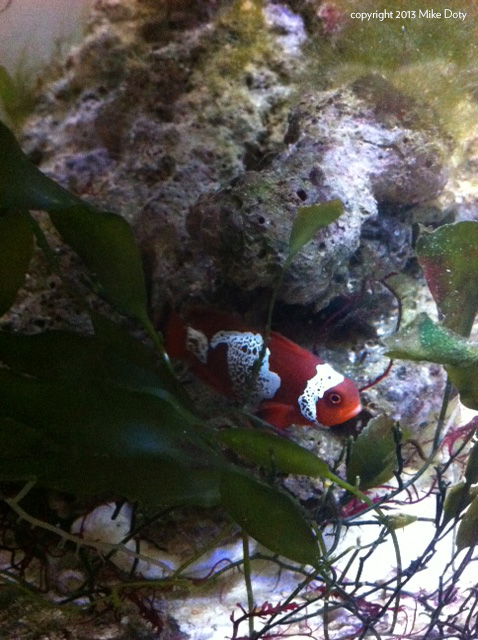
Updated – he just sent over a cell phone shot of the other side.
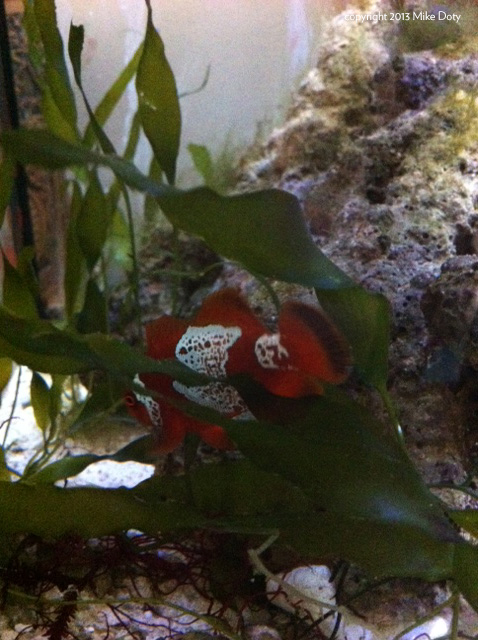
Lookin’ good Mike!
- About The Lightning Project
- Inventory of F1 PNG Lightning and White Stripe Maroon Clownfish
- F1 PNG Lightning Maroon Clownfish, BZLM1
- F1 PNG Lightning Maroon Clownfish, BZLM2
- F1 PNG Lightning Maroon Clownfish, FW1
- F1 PNG Lightning Maroon Clownfish, LM10
- F1 PNG Lightning Maroon Clownfish, LM11
- F1 PNG Lightning Maroon Clownfish, LM12
- F1 PNG Lightning Maroon Clownfish, LM13
- F1 PNG Lightning Maroon Clownfish, LM14
- F1 PNG Lightning Maroon Clownfish, LM15
- F1 PNG Lightning Maroon Clownfish, LM16
- F1 PNG Lightning Maroon Clownfish, LM17
- F1 PNG Lightning Maroon Clownfish, LM18
- F1 PNG Lightning Maroon Clownfish, LM19
- F1 PNG Lightning Maroon Clownfish, LM20
- F1 PNG Lightning Maroon Clownfish, LM3
- F1 PNG Lightning Maroon Clownfish, LM4
- F1 PNG Lightning Maroon Clownfish, LM5
- F1 PNG Lightning Maroon Clownfish, LM6
- F1 PNG Lightning Maroon Clownfish, LM7
- F1 PNG Lightning Maroon Clownfish, LM8
- F1 PNG Lightning Maroon Clownfish, LM9
- F1 PNG Lightning Maroon Clownfish, MD1
- F1 PNG Lightning Maroon Clownfish, MWP3
- F1 PNG Lightning Maroon Clownfish, WS17
- F1 PNG Lightning Maroon, EC1
- F1 PNG Lightning Maroon, GL1
- F1 PNG White Stripe Maroon Clownfish, BZWS1
- F1 PNG White Stripe Maroon Clownfish, BZWS2
- F1 PNG White Stripe Maroon Clownfish, BZWS3
- F1 PNG White Stripe Maroon Clownfish, WS10
- F1 PNG White Stripe Maroon Clownfish, WS11
- F1 PNG White Stripe Maroon Clownfish, WS12
- F1 PNG White Stripe Maroon Clownfish, WS13
- F1 PNG White Stripe Maroon Clownfish, WS14
- F1 PNG White Stripe Maroon Clownfish, WS15
- F1 PNG White Stripe Maroon Clownfish, WS16
- F1 PNG White Stripe Maroon Clownfish, WS4
- F1 PNG White Stripe Maroon Clownfish, WS5
- F1 PNG White Stripe Maroon Clownfish, WS6
- F1 PNG White Stripe Maroon Clownfish, WS7
- F1 PNG White Stripe Maroon Clownfish, WS8
- F1 PNG White Stripe Maroon Clownfish, WS9
- F1 PNG White Stripe Maroon, EC2
- F1 PNG White Stripe Maroon, FW2
- F1 PNG White Stripe Maroon, GL2
- F1 PNG White Stripe Maroon, MD2
- Lightning Breeding Directive
- Lightning Maroon Clownfish Links
- Home
- About The Lightning Project
- Inventory of F1 PNG Lightning and White Stripe Maroon Clownfish
- F1 PNG Lightning Maroon Clownfish, BZLM1
- F1 PNG Lightning Maroon Clownfish, BZLM2
- F1 PNG Lightning Maroon Clownfish, FW1
- F1 PNG Lightning Maroon Clownfish, LM10
- F1 PNG Lightning Maroon Clownfish, LM11
- F1 PNG Lightning Maroon Clownfish, LM12
- F1 PNG Lightning Maroon Clownfish, LM13
- F1 PNG Lightning Maroon Clownfish, LM14
- F1 PNG Lightning Maroon Clownfish, LM15
- F1 PNG Lightning Maroon Clownfish, LM16
- F1 PNG Lightning Maroon Clownfish, LM17
- F1 PNG Lightning Maroon Clownfish, LM18
- F1 PNG Lightning Maroon Clownfish, LM19
- F1 PNG Lightning Maroon Clownfish, LM20
- F1 PNG Lightning Maroon Clownfish, LM3
- F1 PNG Lightning Maroon Clownfish, LM4
- F1 PNG Lightning Maroon Clownfish, LM5
- F1 PNG Lightning Maroon Clownfish, LM6
- F1 PNG Lightning Maroon Clownfish, LM7
- F1 PNG Lightning Maroon Clownfish, LM8
- F1 PNG Lightning Maroon Clownfish, LM9
- F1 PNG Lightning Maroon Clownfish, MD1
- F1 PNG Lightning Maroon Clownfish, MWP3
- F1 PNG Lightning Maroon Clownfish, WS17
- F1 PNG Lightning Maroon, EC1
- F1 PNG Lightning Maroon, GL1
- F1 PNG White Stripe Maroon Clownfish, BZWS1
- F1 PNG White Stripe Maroon Clownfish, BZWS2
- F1 PNG White Stripe Maroon Clownfish, BZWS3
- F1 PNG White Stripe Maroon Clownfish, WS10
- F1 PNG White Stripe Maroon Clownfish, WS11
- F1 PNG White Stripe Maroon Clownfish, WS12
- F1 PNG White Stripe Maroon Clownfish, WS13
- F1 PNG White Stripe Maroon Clownfish, WS14
- F1 PNG White Stripe Maroon Clownfish, WS15
- F1 PNG White Stripe Maroon Clownfish, WS16
- F1 PNG White Stripe Maroon Clownfish, WS4
- F1 PNG White Stripe Maroon Clownfish, WS5
- F1 PNG White Stripe Maroon Clownfish, WS6
- F1 PNG White Stripe Maroon Clownfish, WS7
- F1 PNG White Stripe Maroon Clownfish, WS8
- F1 PNG White Stripe Maroon Clownfish, WS9
- F1 PNG White Stripe Maroon, EC2
- F1 PNG White Stripe Maroon, FW2
- F1 PNG White Stripe Maroon, GL2
- F1 PNG White Stripe Maroon, MD2
- Lightning Breeding Directive
- Lightning Maroon Clownfish Links
Yes, here it is, has been too long. With each passing day I am evermore convinced that my hypothesis about the Lightning pattern development is correct. The “lightning maroon clownfish pattern development” photo series post has been updated as well. This is what the Lightnings are looking like now.
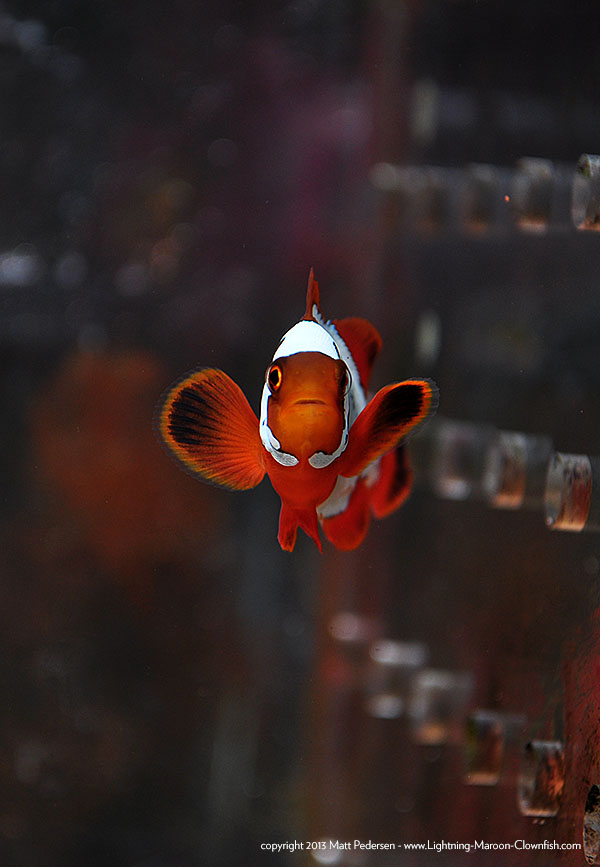
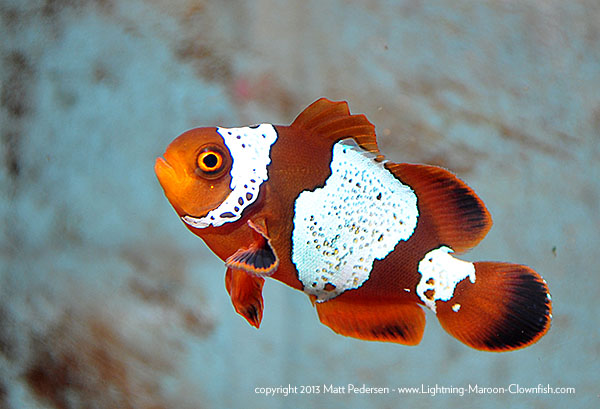
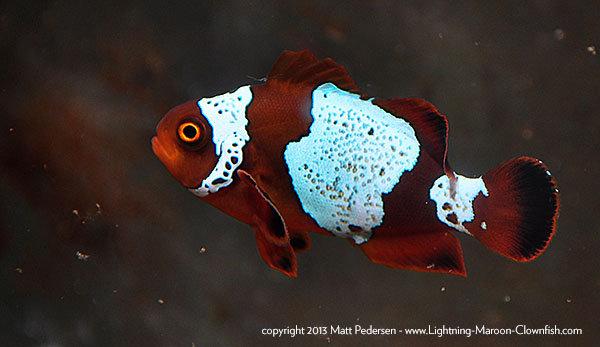
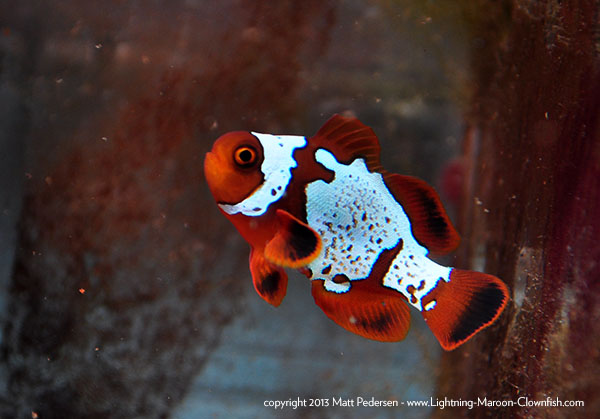
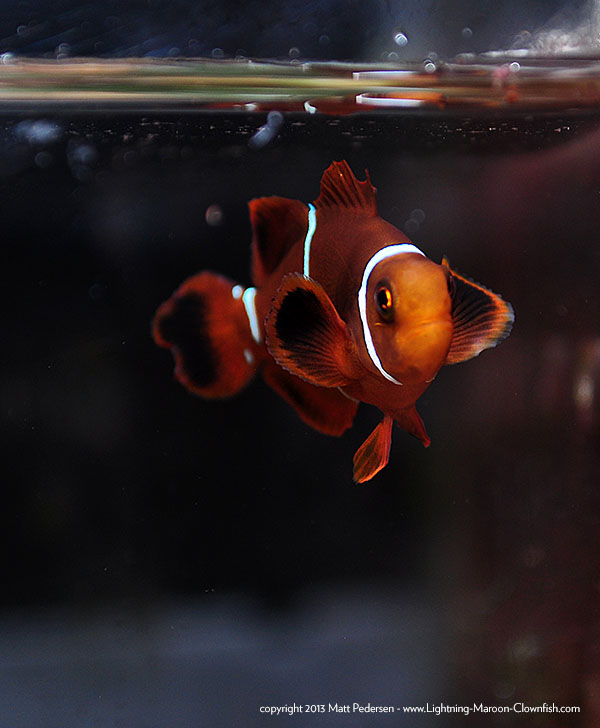
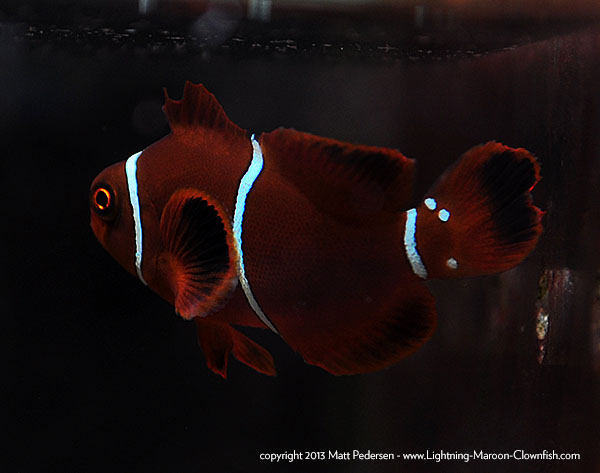
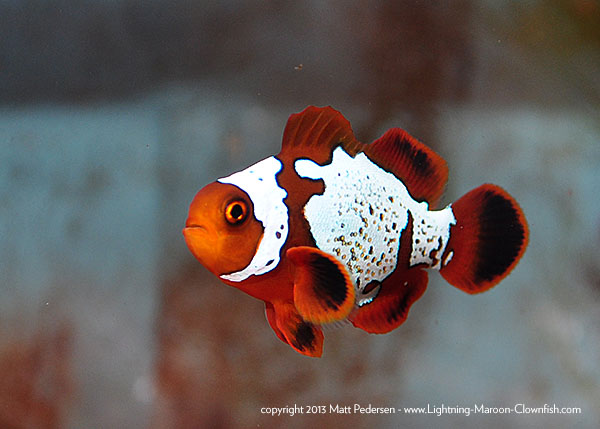
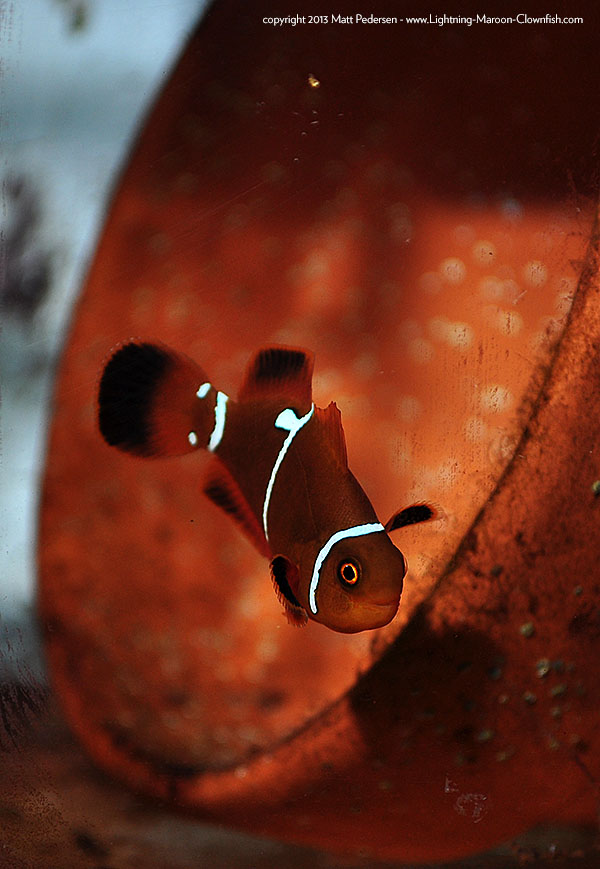
This is the pair I’m holding onto to make a “Lightning” X “Lightning” pairing 😉 Time to start feeding the one on the right twice as often as the one on the left so that 6 months from now, the one on the right is twice as big!
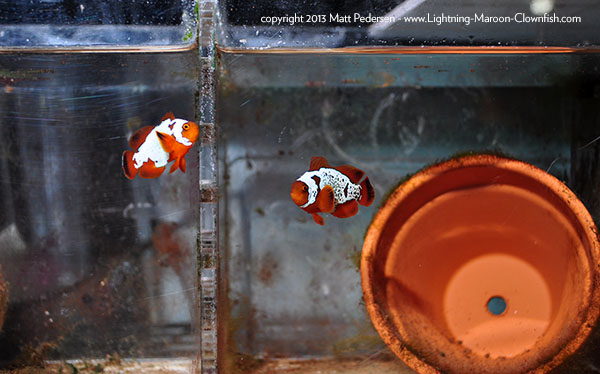
The left fish; future male.
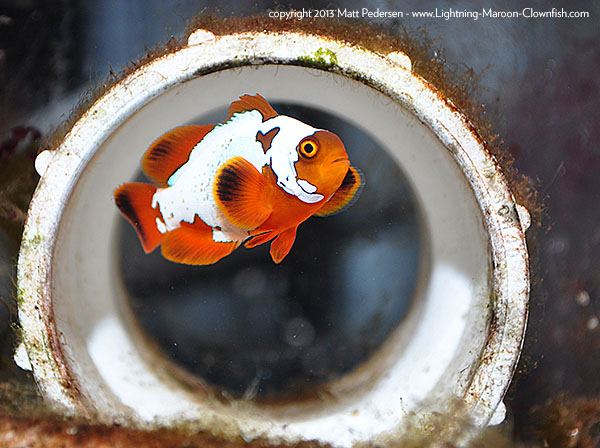
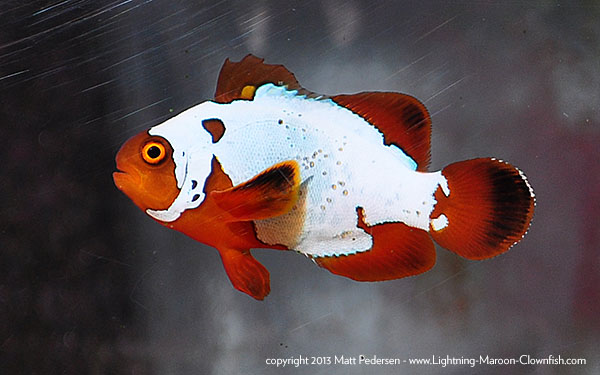
The right fish; future female.
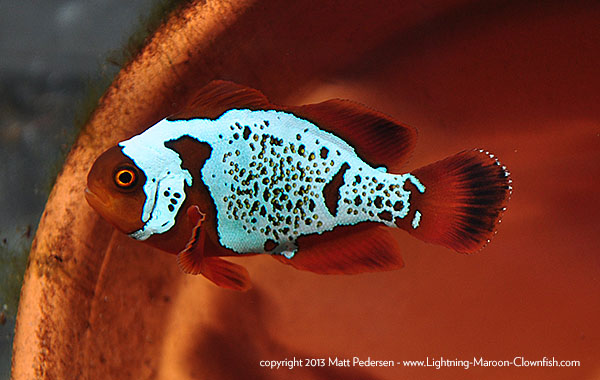
The most interesting thing I’ve noticed is that I’ve made no difference in care other than temperature and lighting; the large group in growout has been at warmer temps and has grown significantly larger and faster. However, under only ambient lighting and in a group setting, they’ve not developed the intensity of color that these isolated specimens have. I’m bringing on the lights to get these fish ready for sale!
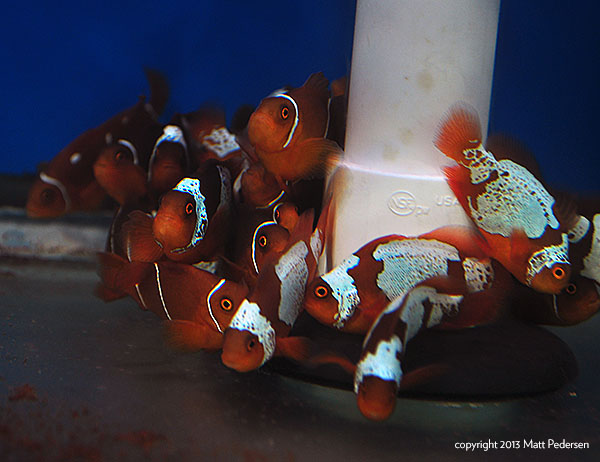
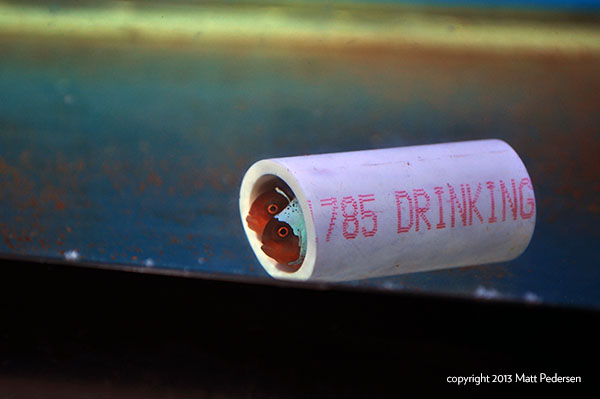
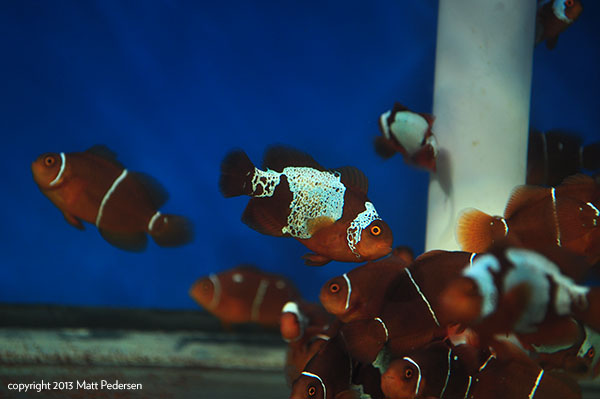

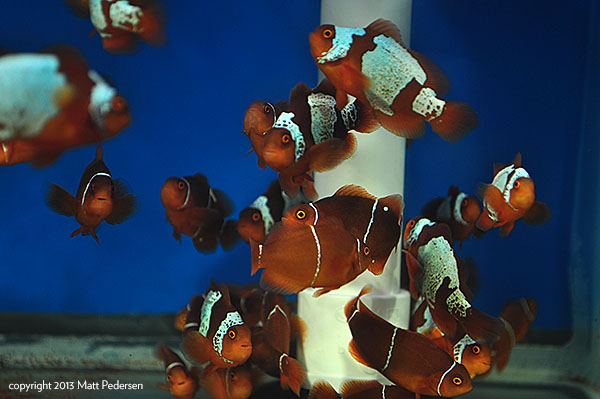
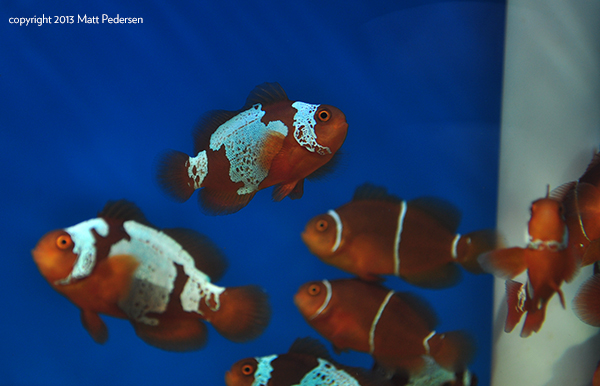
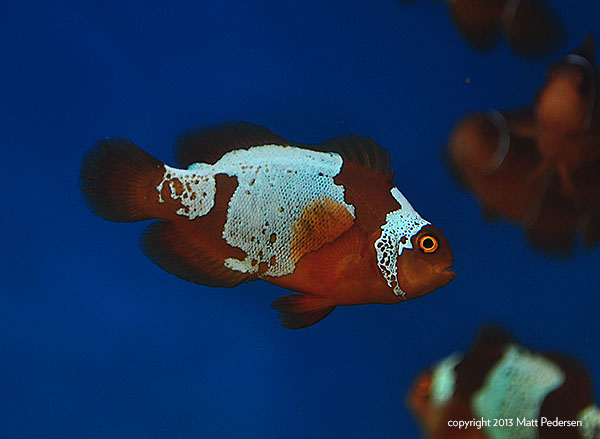
 Last Wednesday, December 5th, I was surprised and saddened to find a few dead Lightning Maroons in the larviculture system. The mortalities were restricted specifically to the large aggregate group. Many of you may be aware that Maroon clownfish are notoriously nasty to each other, so much so that some breeders have said that in white strip variants (which would include our Lightning Maroons) they can rear hundreds of fish and find only FIVE that are sellable. I had been planning for months now to segregate all the fish into individual containers, but each time I look at the fish, they seem happy, and the damage to their fins is less and less noticable. In other words, up until December 5th, the fish themselves had given me no reason to separate them!
Last Wednesday, December 5th, I was surprised and saddened to find a few dead Lightning Maroons in the larviculture system. The mortalities were restricted specifically to the large aggregate group. Many of you may be aware that Maroon clownfish are notoriously nasty to each other, so much so that some breeders have said that in white strip variants (which would include our Lightning Maroons) they can rear hundreds of fish and find only FIVE that are sellable. I had been planning for months now to segregate all the fish into individual containers, but each time I look at the fish, they seem happy, and the damage to their fins is less and less noticable. In other words, up until December 5th, the fish themselves had given me no reason to separate them!
Well, the losses could have been from aggression, or they could have been from too many fish being in the same amount of space. Perhaps the flow of water into their tank had been disrupted for a time. Ultimately, I’m simply not sure what caused the losses. One of the most interesting things I’ve noticed about the Lightning Maroons growing out is that the ones kept together have grown FASTER than the fish I separated out into individual containers. The ones kept together are also more bold and outgoing.
Since I have a massive 200 gallon+ growout system here, designed specifically to grow fish out, I opted to MOVE all the Lightning Maroon offspring together into a 33 gallon breeder on the system. I took this opportunity to do a headcount – of course now I cannot remember, but I think within the group, I counted around 48 fish (keep in mind I’ve given away 2 so far, and I fond out I missed 3 in the bucket, plus I have 14 in the cube runs, and I lost at least 3 + I had one jump along the way). So my guestimate of 60-70 fish may have been very close.
At this point, the fish are getting “big”. I had hoped to be selling some at this point, but we simply haven’t gotten there yet and holiday shipping traffic means that it is exceptionally risky to ship fish this time of year. Better to wait. So at this point, we probably won’t be selling any of these until after the first of the year. Honestly, I’d LOVE to send them out sooner, but it’s just not in the cards!
In the meantime, you can enjoy some new photos!
First, some shots of my favorite and a bonus shot of one of the “runty” ones.
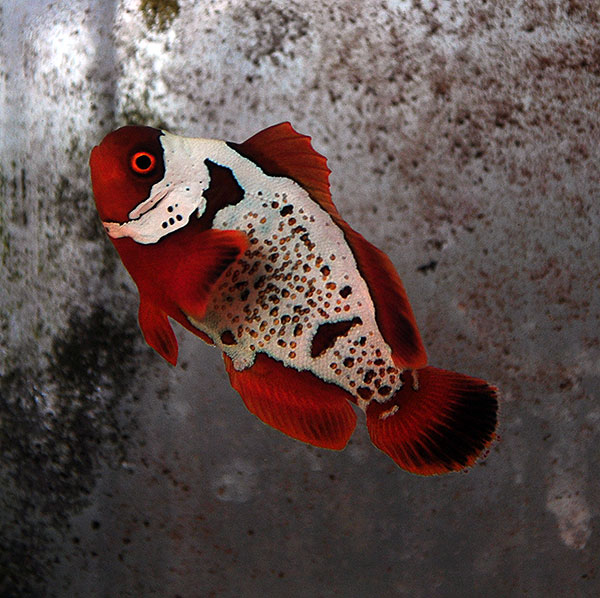
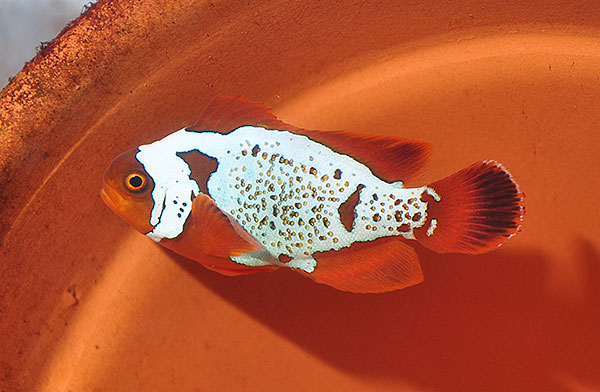
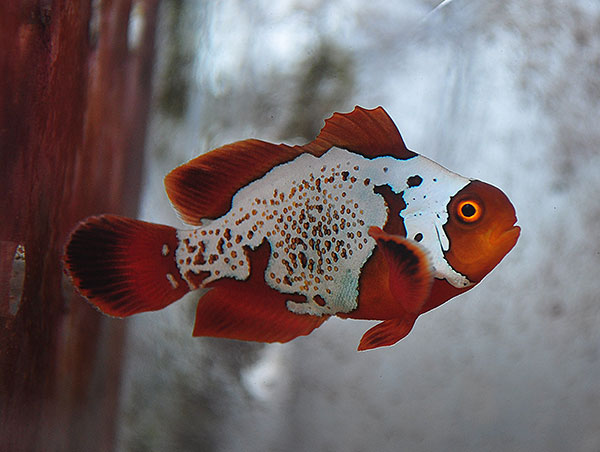
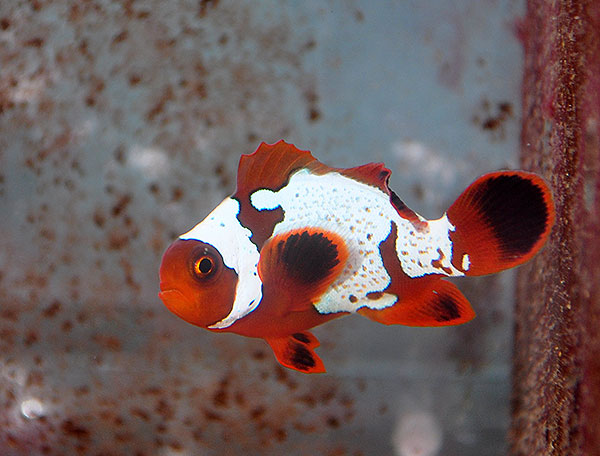
I’ve also gone back and updated the “month by month” progression post showing the pattern development on my favorite one.
And finally, some shots of the group of juveniles in the growout system…it has a bit of a cloudy water issue, which is odd because it has a massive skimmer and a sock filter…I’m thinking it’s biopellet related and make take it offline to see if that remedies the situation. If not, water changes are in the forecast!
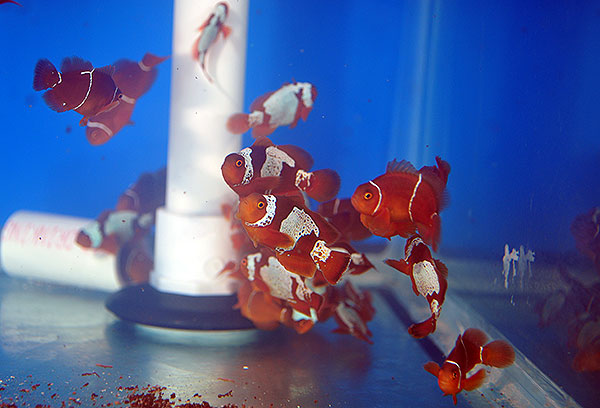
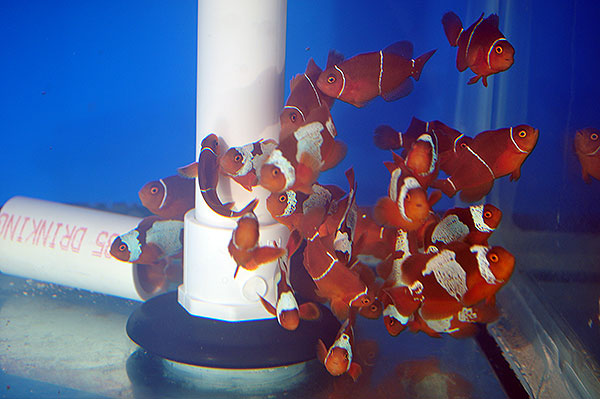
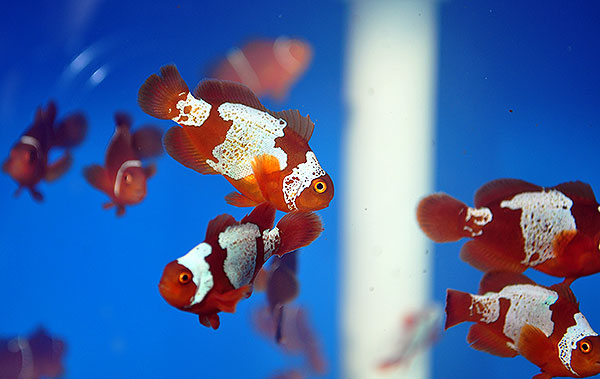
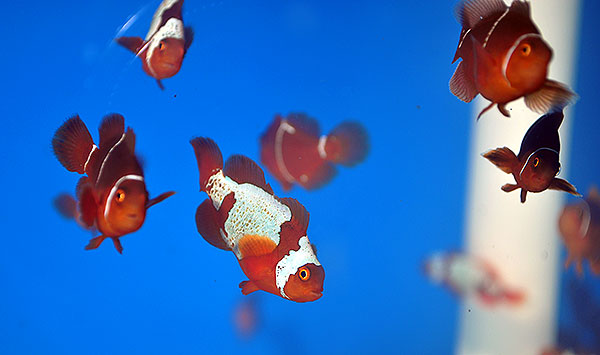
Craig’s comments today got me thinking – I should show the progression of the pattern developing. So this is for you Craig! These are all the same fish; this is one I’ve decided to keep for myself…looks like it lost a ventral fin in early fights but is otherwise a really nice fish (take note, you can see how the damaged ventral fin has regrown / regenerated…looks like the other atrophied). I’ll keep showing this fish in future progressions most likely.
August 8th, 2012

September 13th, 2012
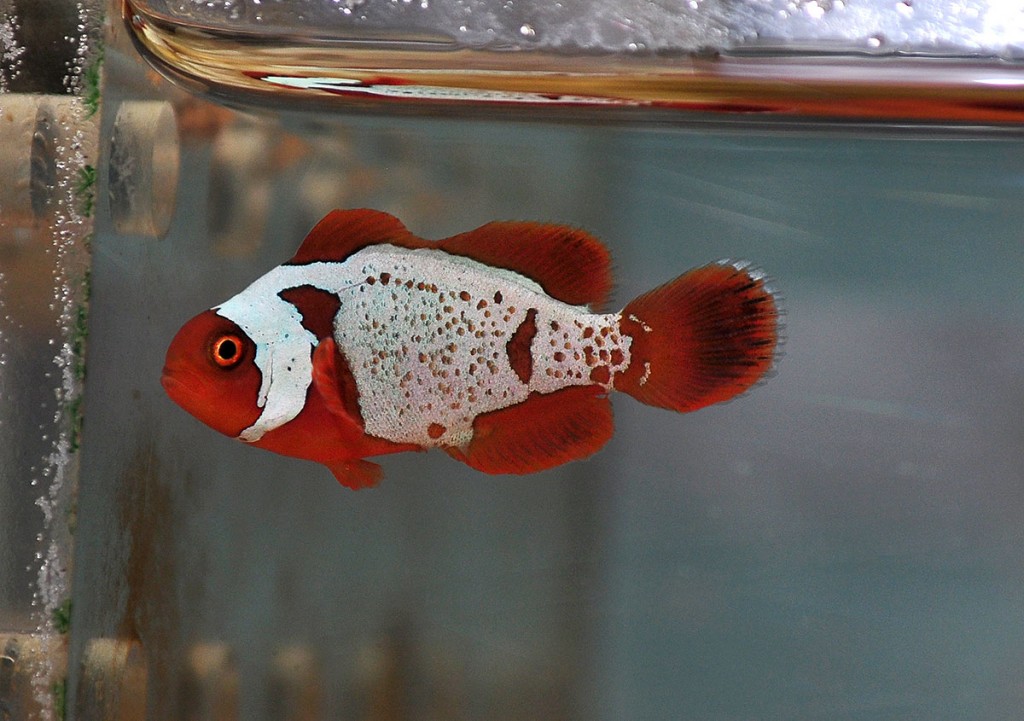
October 23rd, 2012
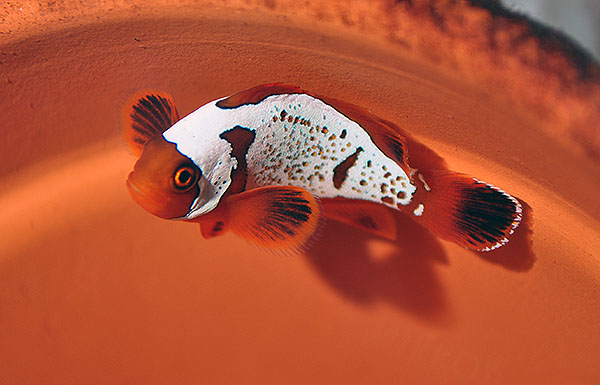
November 13th, 2012
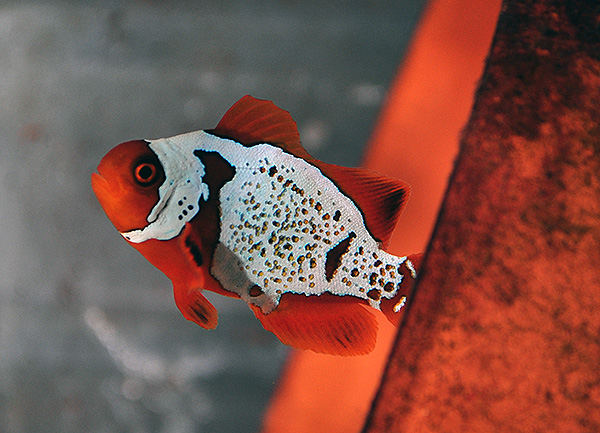
December 13th, 2012

February 22nd, 2013

March 23rd, 2013
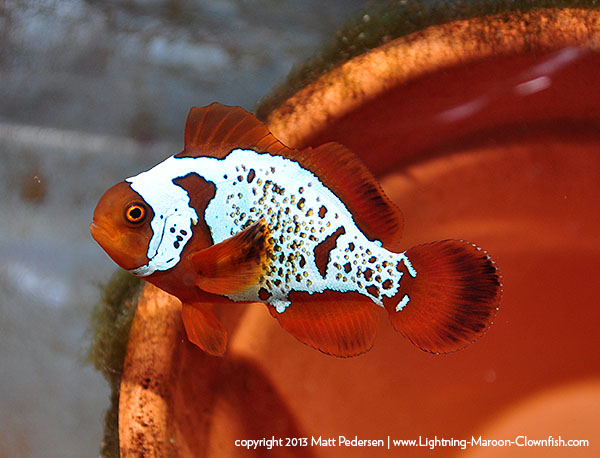
June 18th, 2013
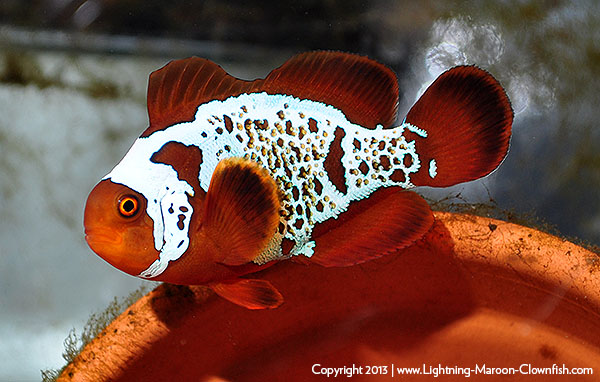
July 31st, 2013
August 28th, 2013
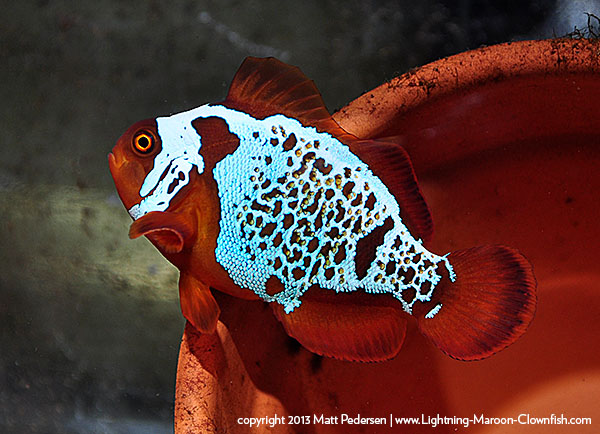
October 14th, 2013
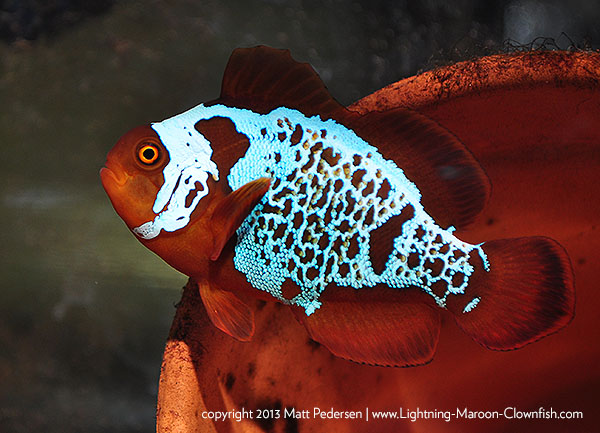
December 13th, 2013
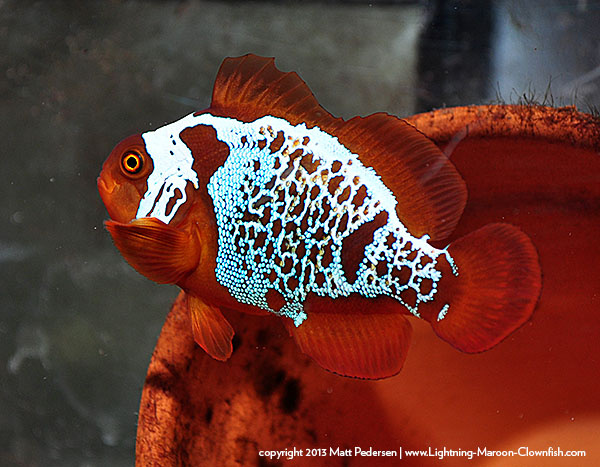
June 15th, 2014
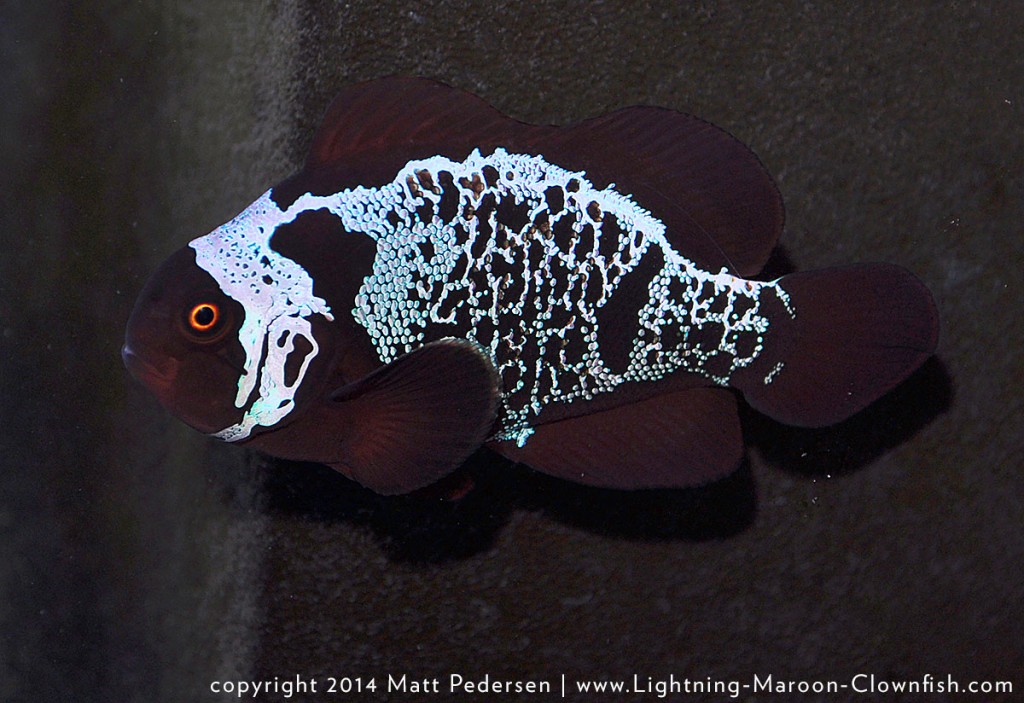
*NEW* November 3rd, 2015
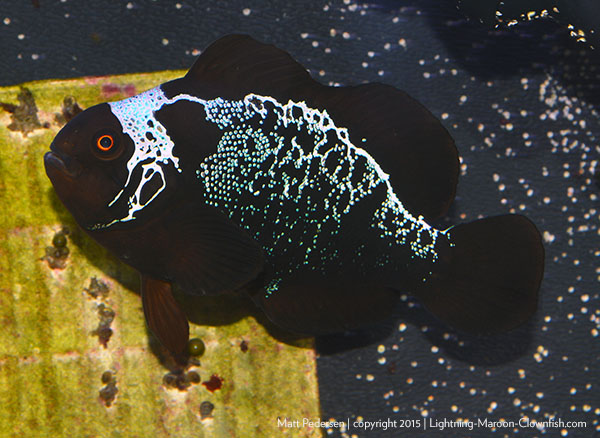
Update – 6/23/2013 – I talk about this frequently, but I realized I should add this commentary here, on the pattern progress post. Here’s my theory on what you’re seeing:
1 – “Lightning” Babies are very obvious compared to their white stripe siblings. They show up with tremendously thicker bars.
2 – For a certain period of time, as they grow, the white overbarring spreads and takes shape.
3 – Meanwhile, subtractive pattern development also starts occuring. You see it in the white areas first as pinholes and dots.
4 – As the fish grows, the areas of “white loss” continue to emerge, and to spread. What was once solid areas of white start to break up, with white scales giving way to red patterning inbetween.
5 – As the fish continues to grow and age, the red areas become ever more pronounced.
6 – It is my speculation that the “white loss” pattern development continues over the course of at least 2-3 years, but perhaps even longer. The original Lightning Maroon today seems to have less white than it did when it arrived 3 years prior. I suspect that the timeline from a captive-bred Lightning Maroon clown going from hatched to what we might consider a “true” Lightning Maroon..that is a fish showing the balance of white and red comparable to the original foundation fish, is going to take at least 2-3 years.
Considering that I’ve personally documented coloration development in Percula going up to 3 years out, this is completely not unheard of, but nothing to the extent of what the Lightning Maroons seem to present. I look at these fish and they way they are “patterning up” and I am floored – I never could have guessed that THIS is the mechanism by which the Lightning Pattern would be “created” on the fish. At this point it definitely takes vision to have complete buy-in to my hypothesis, but I’m thoroughly convinced I’m right. Which means that in the long run, hobbyists might buy a fish like the one from October, 2012 show above…and 2 years later have something completely different from that…and looking a lot more like the “Lightning”. How freakin’ cool is that – a fish that truly only gets better with age?!
You knew it would happen, I said it would happen. You can’t keep this much electricity locked up without having to get some discharged.
And so it comes to pass that last Thursday, October 11th, the first two offspring of the Lightning Maroon left my basement and traveled 4 blocks away to Mike’s house. One Lightning Baby, and one “Horned” baby. Now, these are both cull quality fish top to bottom, but who knows how they might grow in. I say that, because some of the “culled” fish that I pulled up..fish that had missing ventral fins for example, have now grown them in!!! Amazing how abusive these fish are to each other, but also amazing how resilient they are. And in picking Mike’s fish, I got a much better look at most of the babies, and I have to say that my earlier assessment on their quality may have been overly harsh. I need to do a photo shoot and ultimately, get them separated out, which I have still yet to do (they’re not killing each other, so I’m not getting much motivation from them!)
Bottom line, we can all breathe just a little easier knowing that we now have a slight diversification of risk on the Lightning Genetics. Not 100% of the eggs in one basket now. This is the first of three planned sets to be passed on to locals as thanks and “backups”. I look forward to more diversification of risk in the weeks ahead!


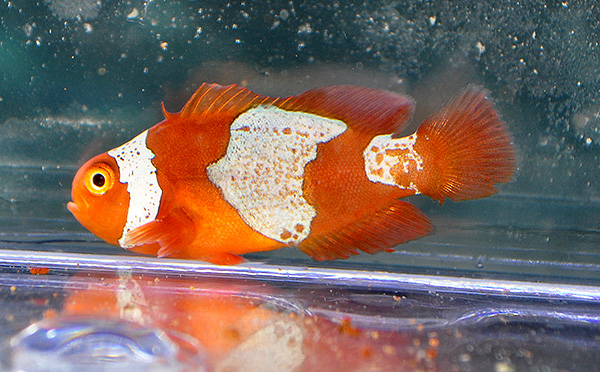
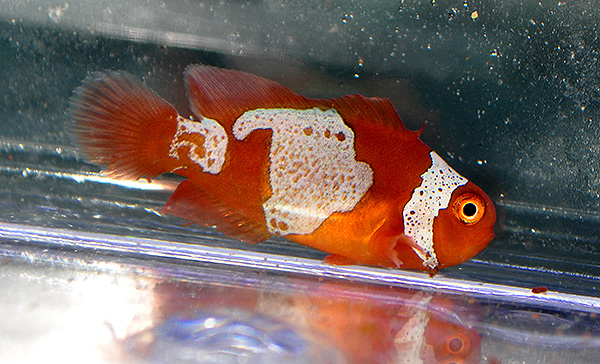
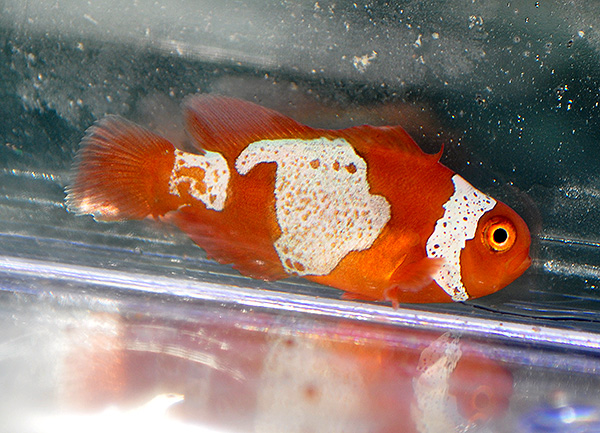
You missed a lot of Lightning Maroon Clownfish news! Of course, the “news” can be summed up in pictorial form.
8-15-2012

9-5-2012
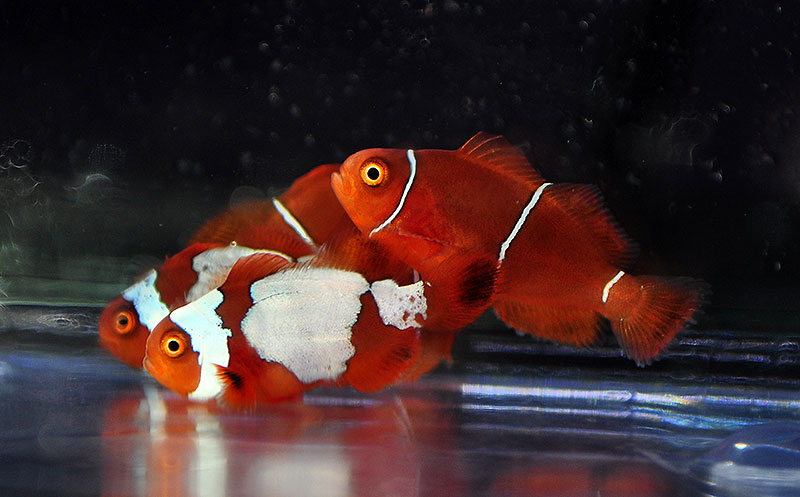
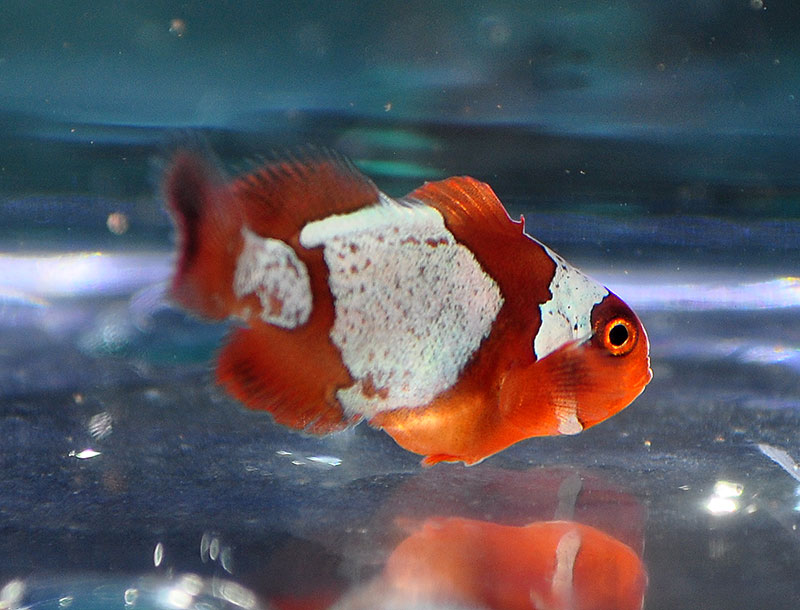
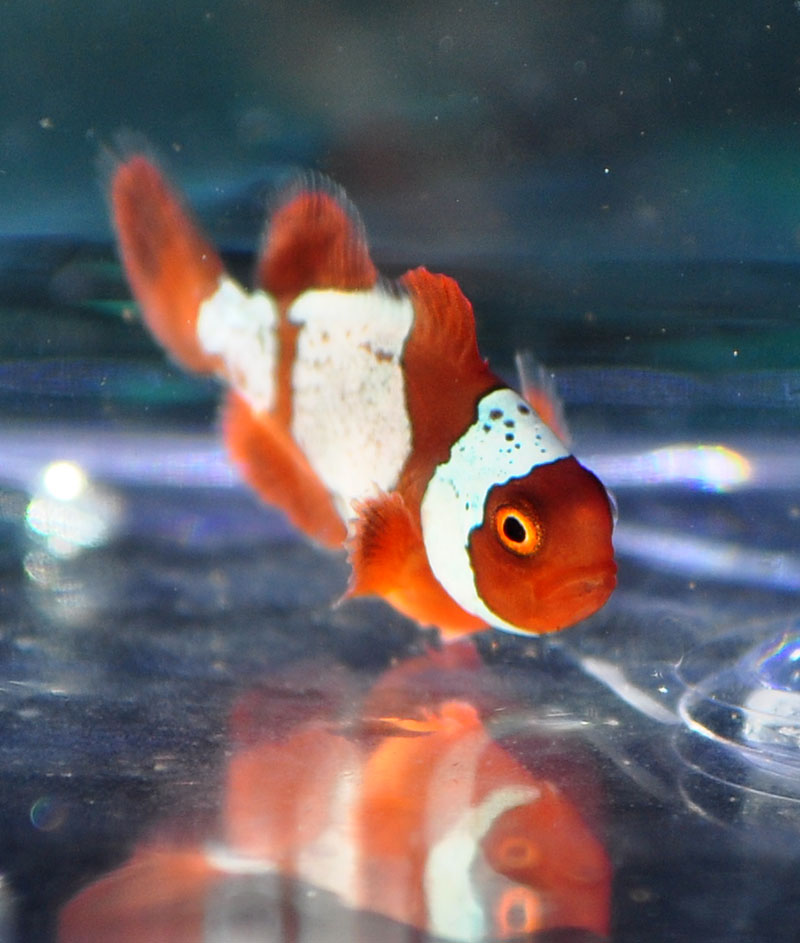
‘9-13-2012

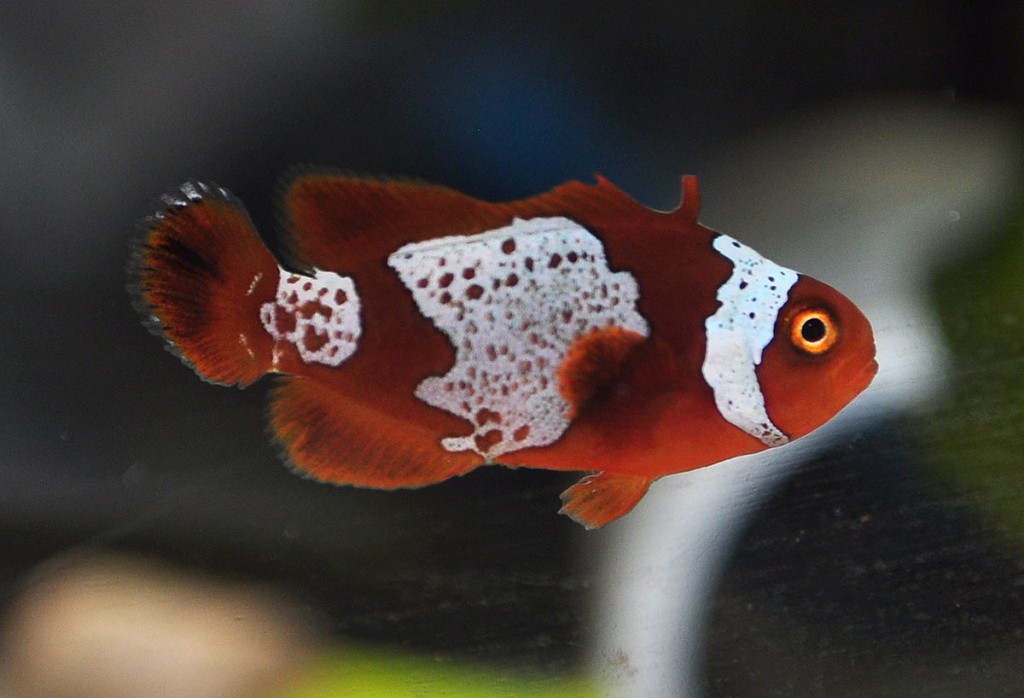
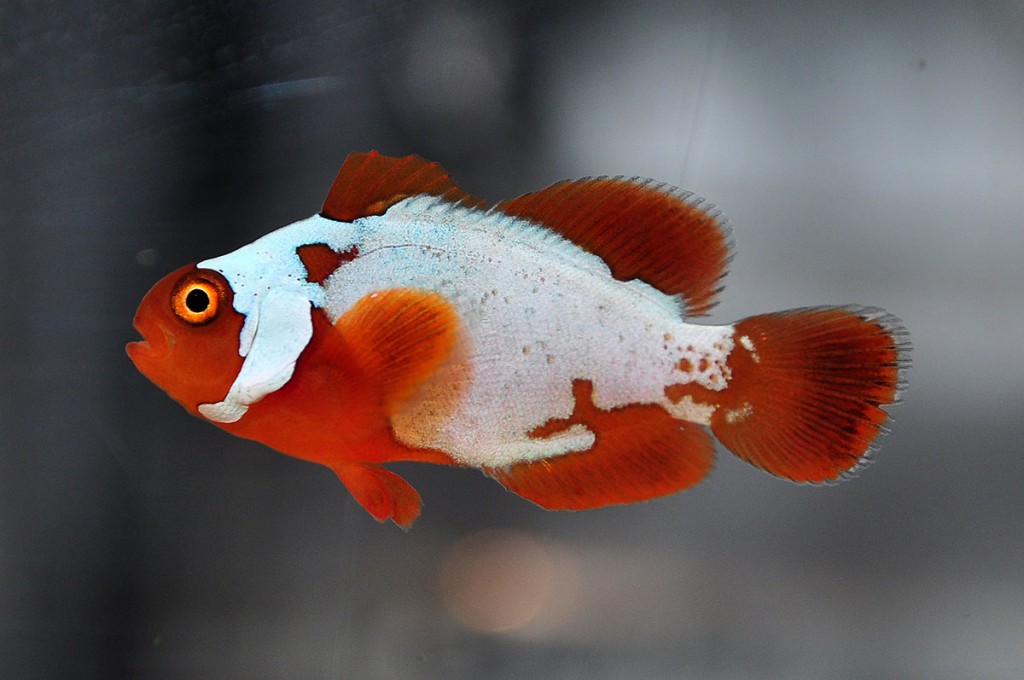

9-27-2012
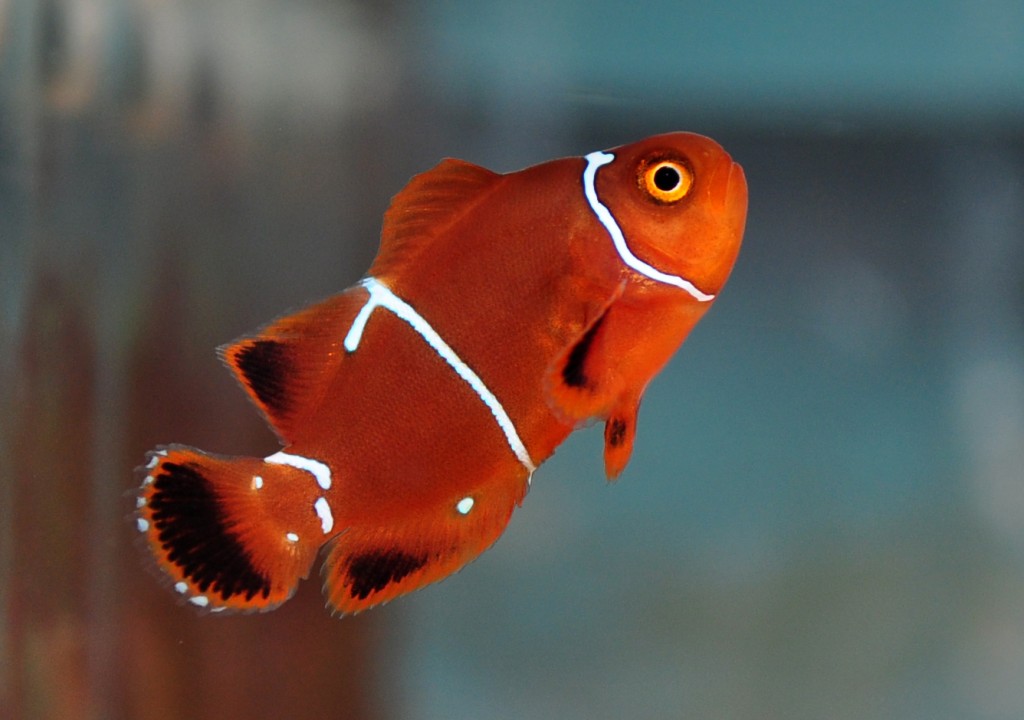
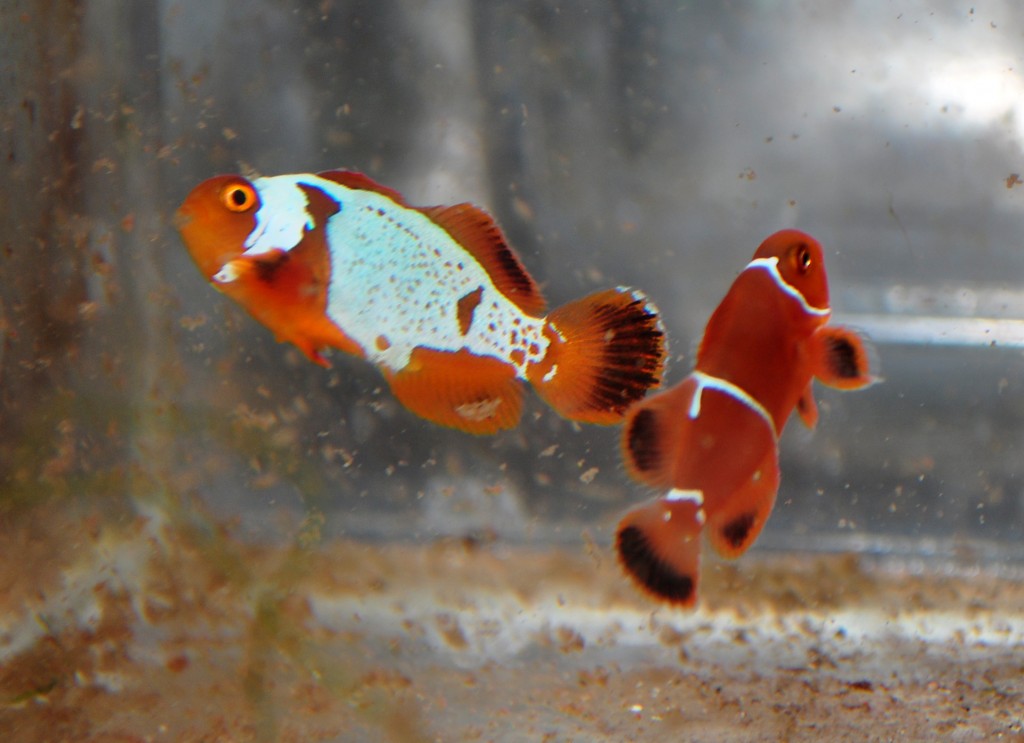
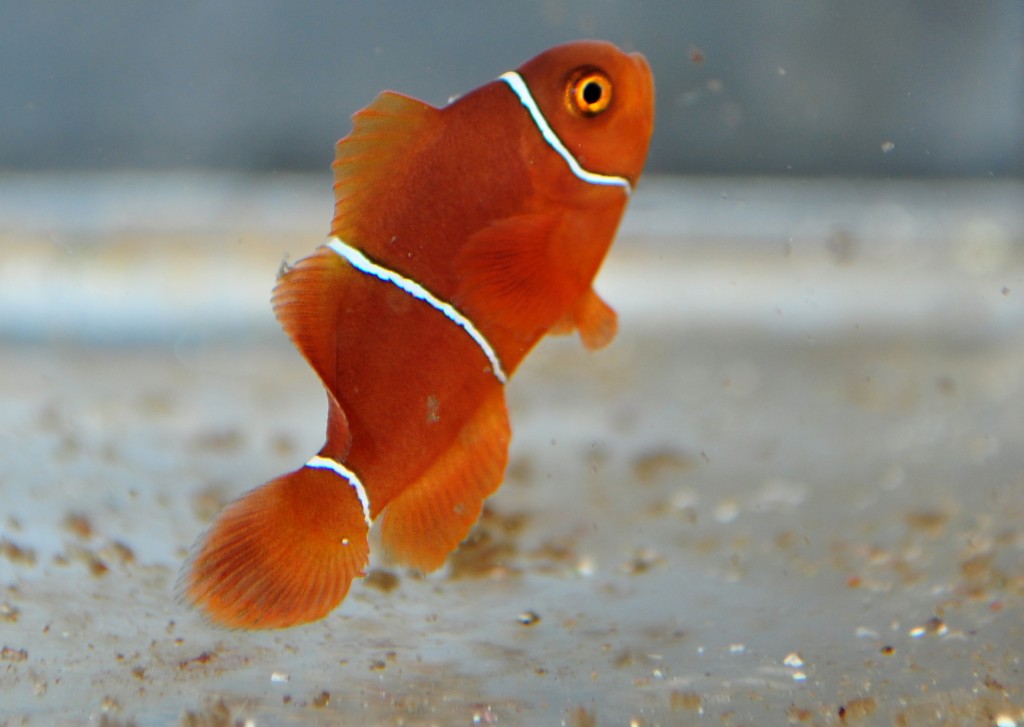


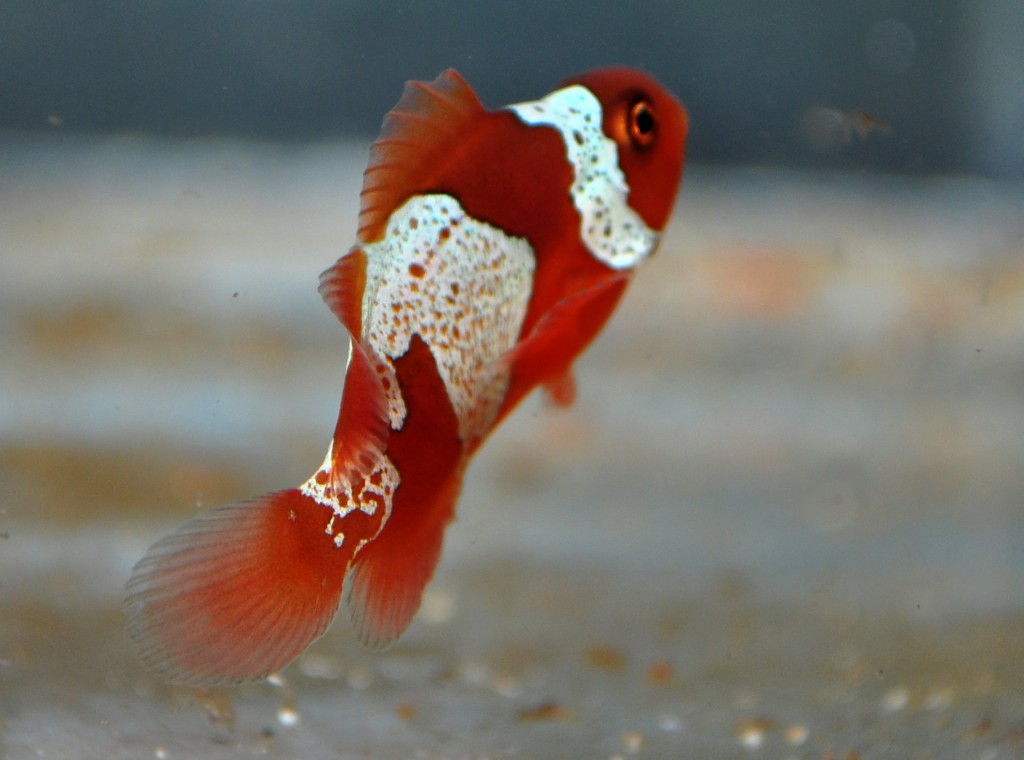
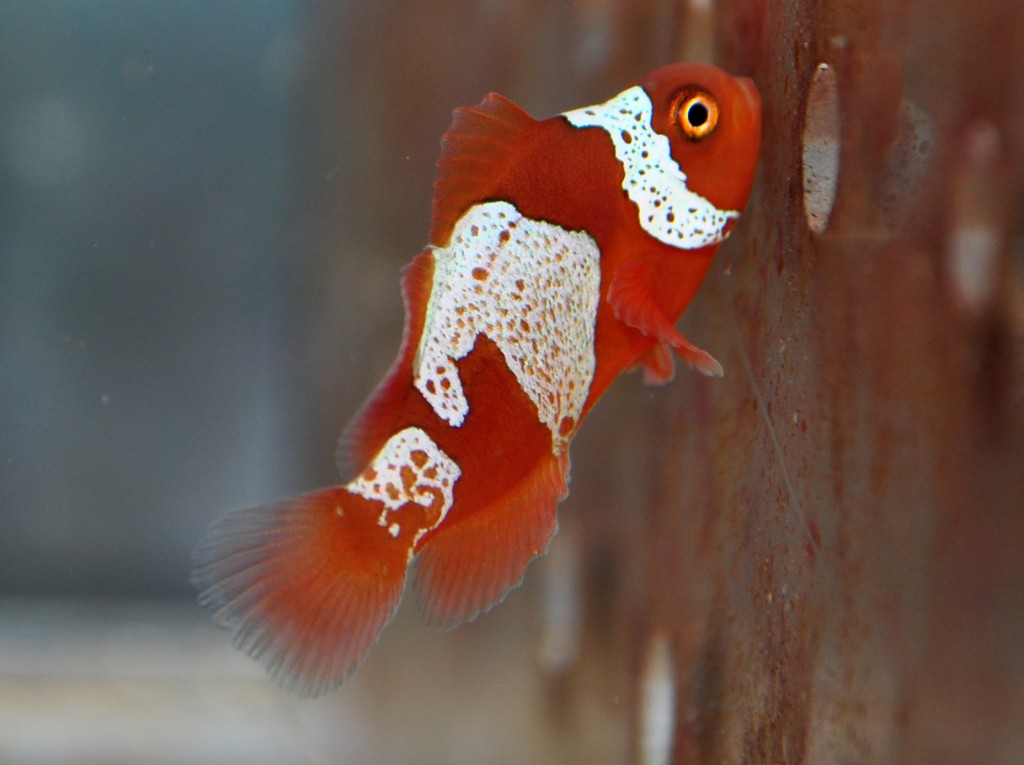
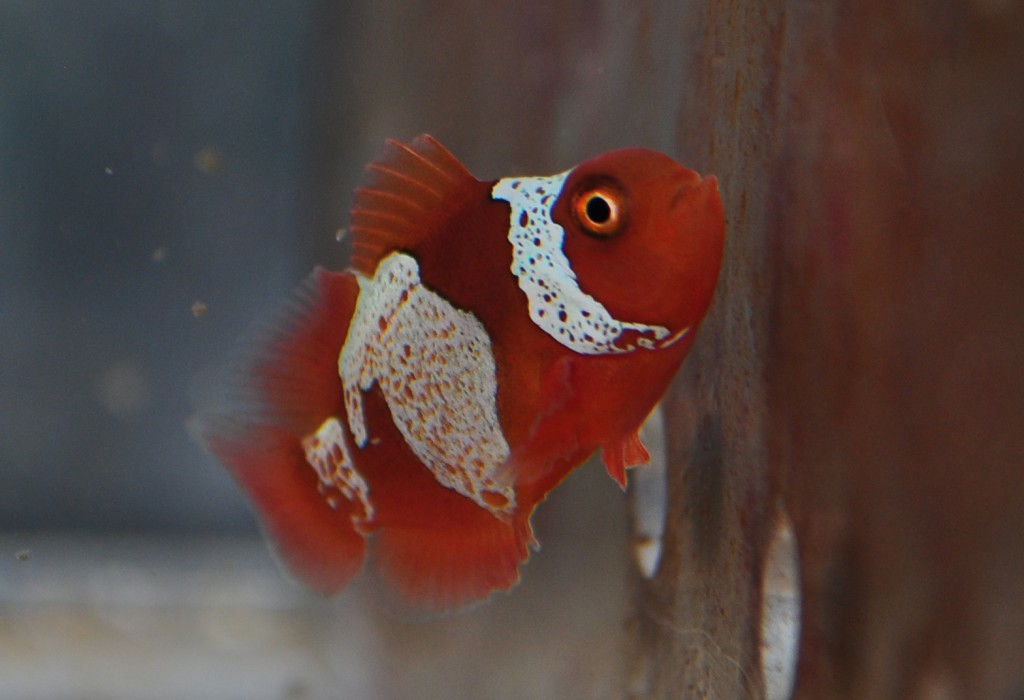
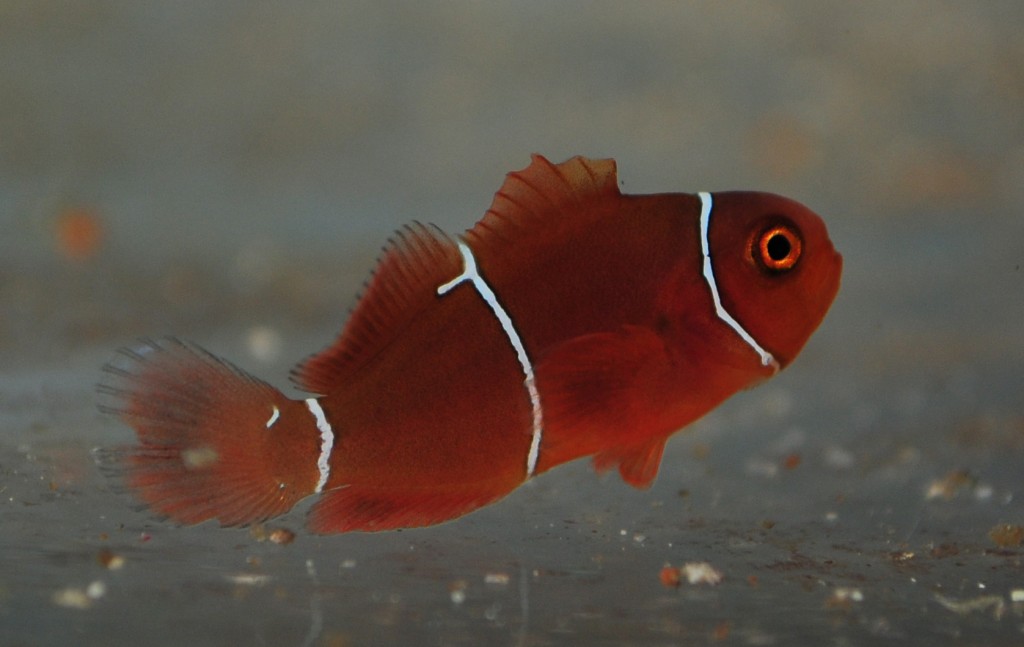
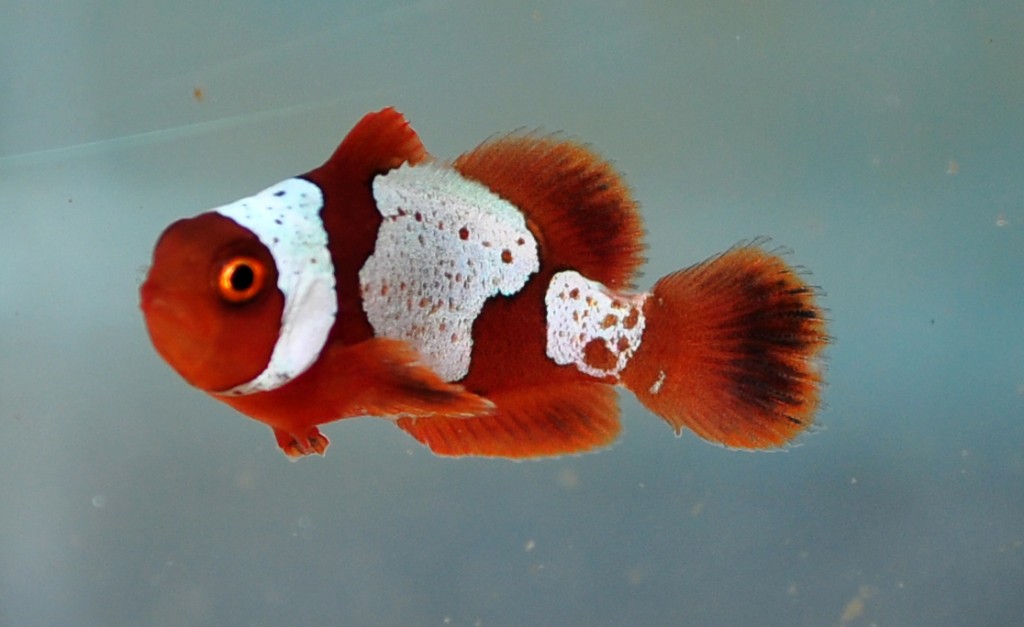
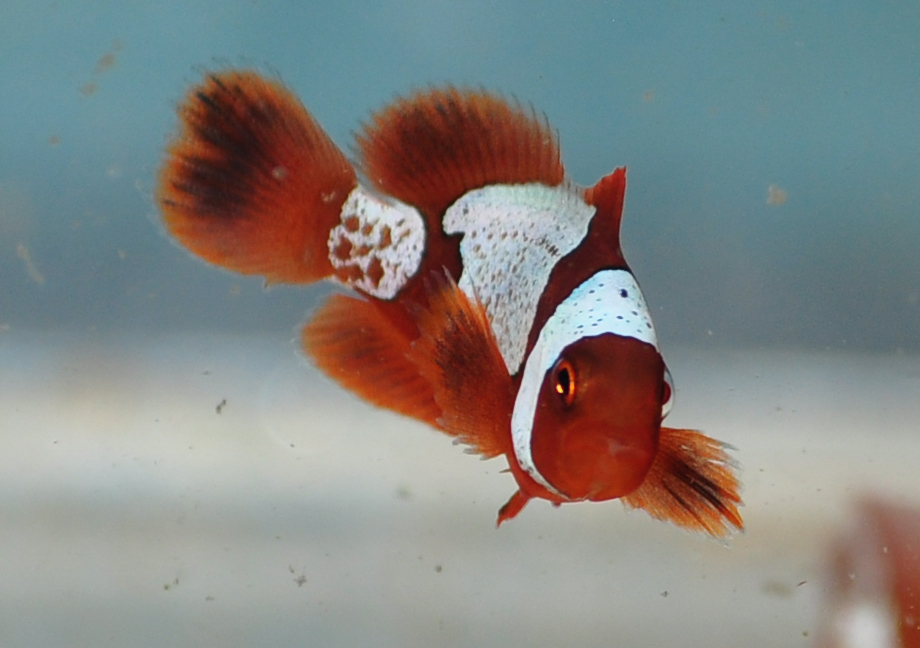
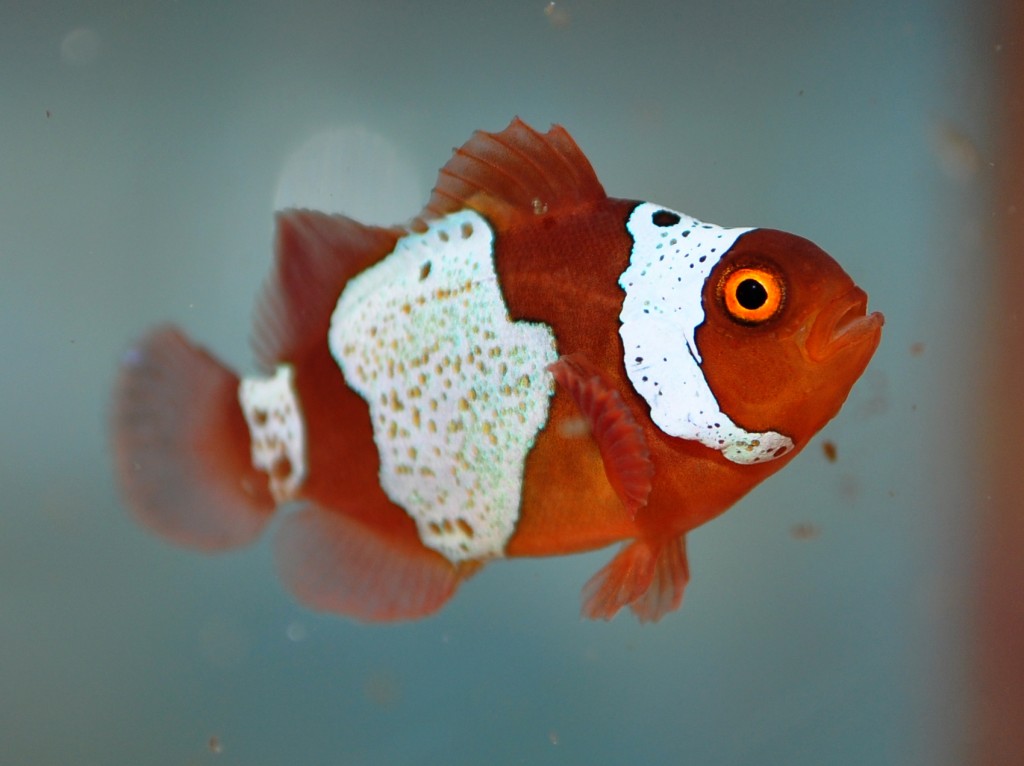
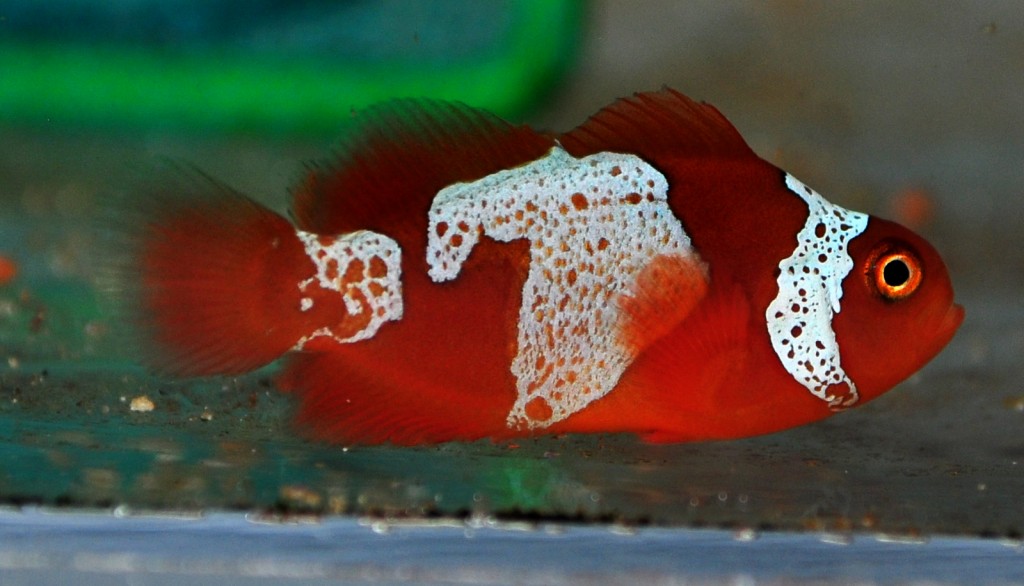
At this point, the fish are around 1″ total length…maybe a hair more on the largest. Still quite small. Not every fish is perfect – in fact, I’m pretty unhappy with how the majority turned out…will be a fair number of culls I think. Still, a lot of good genetic material is on hand to play with! I also divulged my basic plan for the offspring at MACNA, so here goes:
Approximately 3 pairs will be held back for my personal breeding efforts. 3 pairs will go to local breeders. Culls will be offered to established commercial breeding operations for genetic material to work with (the assumption here being that culls were the product of the environment and fighting, hopefully not genetic issues). The remaining top tier fish will be sold at retail, probably at auction, to the general public. My anticipation is that there will be maybe 30-40 fish at most to offer, which translates to only 15-20 Lightnings max. Once again, time to start saving your pennies (and hundred dollar bills).
Mid September, 2012, ORA released the news that they have developed a line of Goldflake Maroons from aberrant offspring of their Goldstripe breeding program.
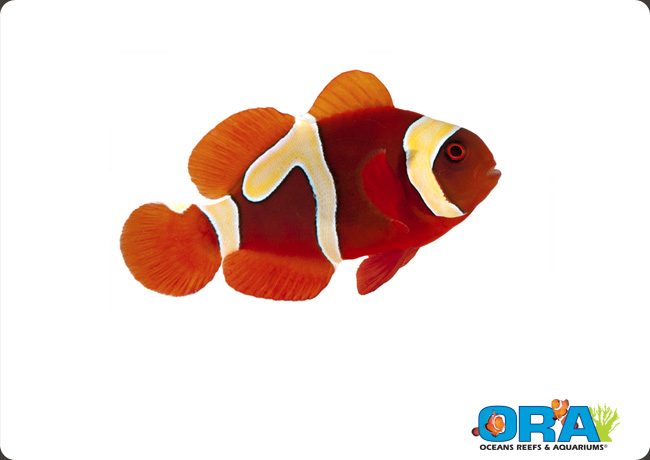
ORA Goldflake Maroon Clownfish, Premnas biaculeatus "ORA Sumatra Goldflake" - image copyright ORA, 2012
This is particularly interesting, as ORA first tried working with a “Jigsaw” White Stripe Maroon, obtained from the Solomon Islands some 8 years back. ORA wrote, “Our experience in breeding Jigsaws was much different than with breeding Picassos and unlike Matt Pedersen with his Lightning Maroon, we didn’t see uniquely patterned offspring from our fish. After several batches of normal White Stripes we focused our efforts on Picassos,Snowflakes and the other designer clownfish we were working with at the time. That Jigsaw is still in broodstock and he’s been spawning reliably for 7 years now!”
Meanwhile, their success with aberrant Gold-Stripe Maroons from Sumatra has really taken off. ORA recounts the development story – “To our surprise, spawns from these select fish did result in increased numbers of uniquely barred offspring. What was once seemingly random had become a reproducible event. We needed to come up with a name. We couldn’t call the fish Jigsaws, because these were Gold Stripes and the pattern was quite a bit different from our wild caught White Stripe. Internally at ORA our staff affectionately called them Funky Maroons but never intended on selling them as such. Within the hobby it seems that Goldflake has become the accepted name for other Gold Stripes with this pattern variation. Rather than come up with an alternate name that would confuse hobbyists we have decided to adopt it. Each Goldflake will have a unique pattern and, depending on the degree of white on the fish, these fish will be graded as regulars or premiums. Some of the premium fish have white that covers nearly half of their bodies. These fish will look absolutely spectacular when the white turns to gold as they mature. While the standard Goldflake will be readily available from ORA, the Premium Goldflakes are still exceptionally rare, perhaps one in 20,000 fish making their availability VERY limited.”
I discussed this fish briefly with Dustin Dorton at MACNA last weekend…it seems they don’t quite have the genetics nailed down yet. When the staff at ORA does figure it out, I hope they will embrace the new tradition of genetic transparency that’s sweeping clownfish breeding and disclose their findings. As I demonstrated at MACNA when I showed the Angelfish genetics, transparency forces breeders to focus on producing quality fish, and that’s something that helps us all.
I encourage you to read more on the initial ORA blog here: http://www.orafarm.com/blog/2012/09/14/goldflake-maroons/ – I left at least one nice “extra” for you (think “all white goldstripe maroon clownfish”)
Be sure to check out the Goldflake Maroon Clownfish Product Page here -> http://www.orafarm.com/products/fish/clowns/goldflake-maroon/
2.5 months already? I’m swamped with MACNA preparations, but Tal Sweet asked me to send a few photos, and wrote up a brief update on Reefs.com – http://www.reefs.com/blog/2012/09/13/lightning-strikes/
Lots more to come, and if you’re at MACNA, be sure to attend the MBI gathering on Friday, where I will give a full update on the project from inception to date, in about 15 minutes time 🙂
PNG fish are certainly taking center stage right now; between Lightning Maroon Clownfish babies, and the new introduction of sustainably-collected PNG fish from EcoAquariums PNG via UniqueCorals.com, there is no shortage of news on the PNG front. The speculation about what Lightning Maroon Clown offspring will sell for hasn’t abated, and to that end, I can still say that nothing has been decided.
I did, however, contact Scott Fellman (of Unique Corals) and Dale Prichard (of Ecoreef UK) to ask how much it cost, at retail, to get one of Dan Navin’s wild-caught PNG White Stripe Maroons, as well as the unique “Horned” and other “Unique” versions that come out of PNG once in a while. What I found is that sustainability does carry a small premium, and by the same token, uniqueness carries it’s own premium pricetag as well. The part that people will find interesting is that these prices suggest a minimum or baseline starting point for what the non-Lightning offspring could go for. That said, it’s safe to assume that there will be additional value on these Lightning-Maroon siblings given the genetic dice-role involved.
Dale Prichard is quick to point out that the UK market is smaller than the US market, as if to suggest that “demand” might be lower and thus, prices would be lower. Maybe, but on the flipside, Dale has been supplying retailers with PNG fish for several months now, so the UK may represent a more valid market to look at. A small normal white stripe maroon from PNG would start retailing at £27; or roughly $45 USD based on recent exchange rates via the Google Currency Converter. That said, Dale relayed that more maroons retail around £40 / $63 USD. A “Horned” Maroon is really going to set you back; while the retail value may be placed at £80 / $126, the reality is that retailers are normally selling these special fish paired with normal white stripes. The net result is your more likely to spend £100 to £120, or $157 to $189 in order to have a PNG “Horned” Maroon Clownfish in your aquarium in the UK. Here’s some examples of the fish Dale Prichard has been seeing come through the Ecoreef UK under his watch, some of which may have been held back for breeding efforts.
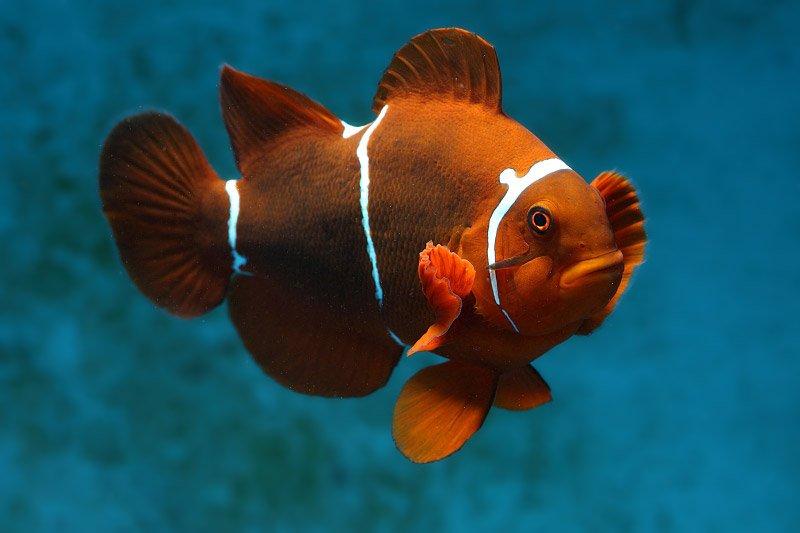
courtesy EcoreefUK ltd and Digital-Reefs.com

courtesy EcoreefUK ltd and Digital-Reefs.com
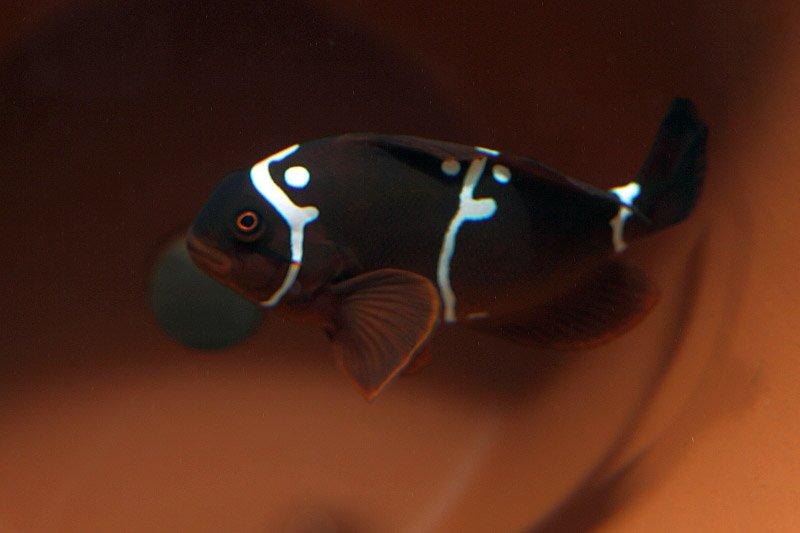
courtesy EcoreefUK ltd and Digital-Reefs.com
Scott Fellman and the team officially launched UniqueCorals.com today, August 22nd, 2012. The opening price for a regularly-striped white stripe maroon from PNG? They’re going to start around $39 each for the smallest size:

courtesy UniqueCorals.com / photo by John Ciotti
A representative shot (not WYSIWYG) – Small normal WS Maroon for – $39 – http://uniquecorals.com/index.php/default/fish-28/anemonefish/premas-biaculeatus-png-maroon-clownfish-small.html
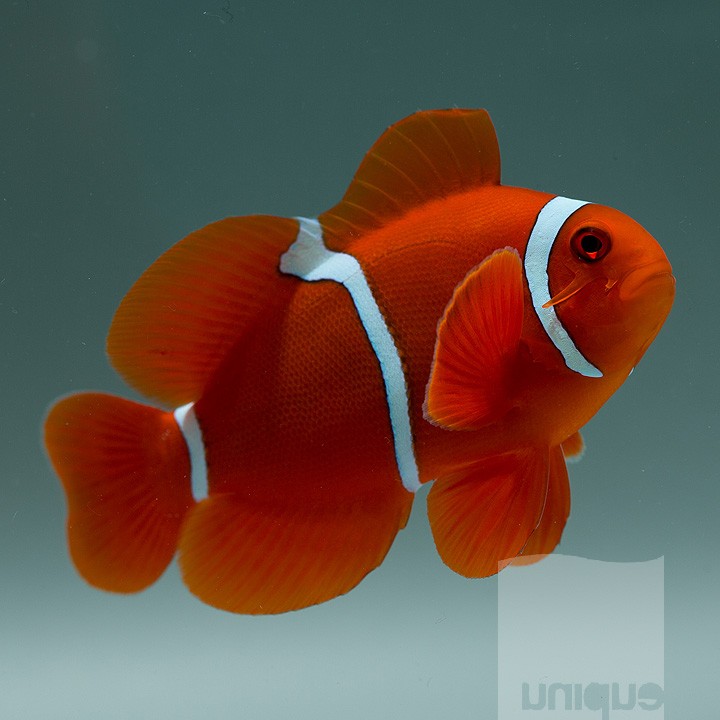
courtesy UniqueCorals.com / photo by John Ciotti
A representative shot (not WYSIWYG) – Medium normal WS Maroon – $49 – http://uniquecorals.com/index.php/default/fish-28/anemonefish/premas-biaculeatus-png-maroon-clownfish-med.html
A uniquely-patterned Maroon from PNG? Expect to be paying in the neighborhood of $150-ish as a starting point, going up as the markings become more elaborate / intricate.
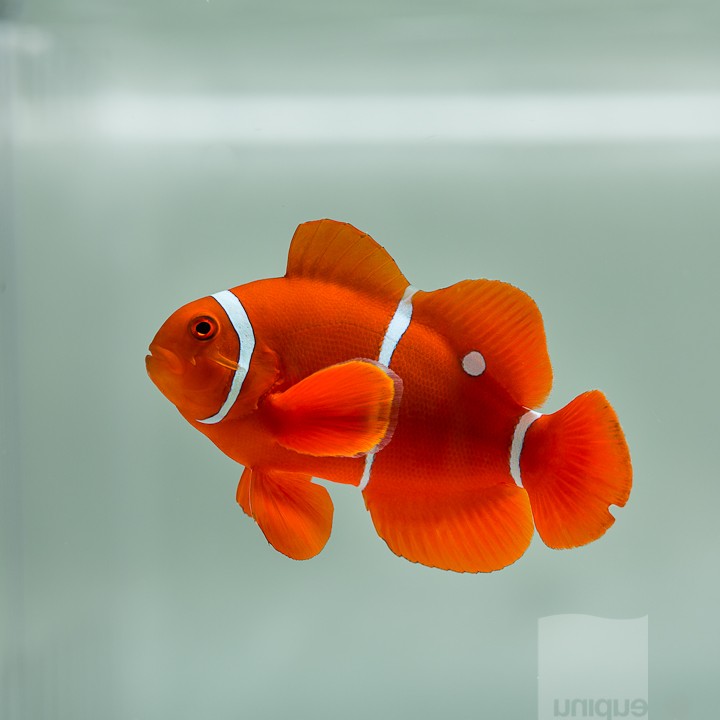
courtesy UniqueCorals.com / photo by John Ciotti
WYSIWYG a “misbar” (has a spot) maroon from PNG – $149 and already sold – http://uniquecorals.com/index.php/default/fish-28/anemonefish/premas-biaculeatus-png-horned-maroon-clownfish-misbar-007247-wysiwyg.html

courtesy UniqueCorals.com / photo by John Ciotti
WYSIWYG, a “horned” maroon from PNG – $200 and already sold – http://uniquecorals.com/index.php/default/fish-28/anemonefish/premas-biaculeatus-png-maroon-clownfish-horned-008131-wysiwyg.html
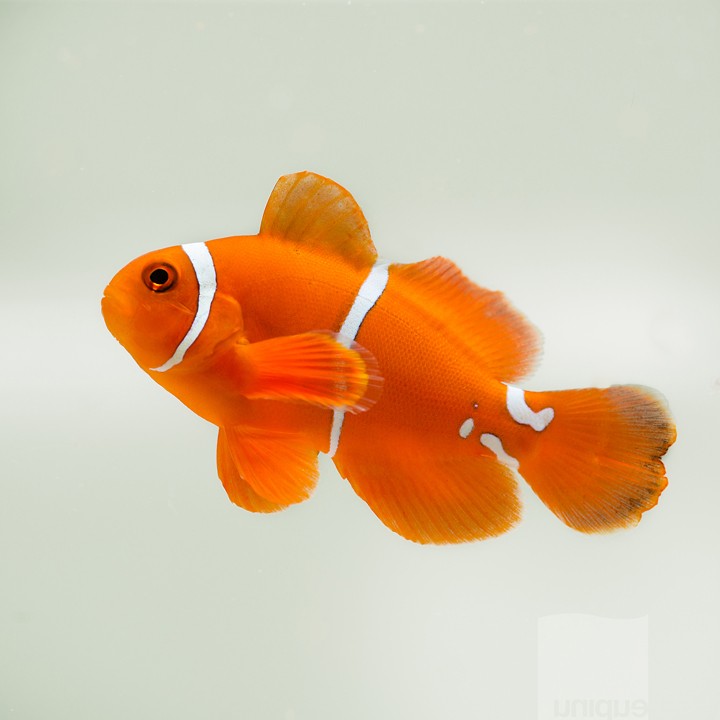
courtesy UniqueCorals.com / photo by John Ciotti
WYSIWYG, a “unique” maroon with lightning-like tail misbarring from PNG – $395 – http://uniquecorals.com/index.php/default/fish-28/anemonefish/premas-biaculeatus-png-maroon-clownfish-misbar-extreme-eco-labeled-png-009764-wysiwyg.html
So realistically, an unusually-marked PNG Maroon with a White-Stripe mate from the only current US-source for wild-caught PNG fish, UniqueCorals.com, is easily going to set you back $200 to $450.
Judging these maroons with other wild caught maroons probably isn’t a fair comparison; owing to the more remote PNG location and the higher level of transparency and data availability, you should fully expect the fish to cost more. For that matter, this might be a real world example of a slow shift towards more expensive wild caught fish ultimately producing the same level of income despite lowered volumes. That could be a very good thing. Scott takes this price discussion one step further when in is quick to remind me that the divers are paid significantly better in the first place. Scott relayed that, “Dan’s fishers are paid a good wage for their work, which, and of itself, helps drive the cost up. Of course, with the higher wages, the fishers place a real economic value on their home reefs, and thus are less likely to resort ot potentially damaging and non-sustainable techniques (ie; dynamite, blast fishing, etc.) to catch as many fishes as they can just to earn a living wage.”
On top of all this, PNG is always going to represent a potentially restricted supply; the government-set TACs (Total Allowable Catches), aka. a “quota” in most fisheries, will automatically place a cap on the number of any species of fish that can be exported from PNG in a given timeframe. This number could further be restricted if updated surveys were to conclude that population numbers were dropping; this is almost textbook fisheries management 101 in my opinion. But apparently I’ve come to learn that this methodology, and the setting of any specific quota, is quite rare marine ornamental fisheries around the globe.
PNG fishes are more than just nice fish with a good back story and a limited supply; they might represent the current ideal in terms of broodstock for captive breeding efforts. Indeed, as breeding moves forward, getting fish from good supply chains with known provenance should represent the bare minimum that a breeder uses in selection of wild stock for propagation. Eg. don’t just settle for any old clownfish; if you’re going to breed Pink Skunks, know if they came from the Marshall Islands, Fiji, Tonga, Vanuatu, Australia, or somewhere else! You never know when some taxonomist or geneticist is going to come along and say “hey, that Marshall Islands form of Pink Skunk is actually not the same species”…wouldn’t it be nice to know that you had that “new species” already breeding in your broodstock collection?
But getting back to PNG and “Horned” Maroons, remember that the EcoAquariums Ltd. fish aren’t just going to the UK, and now the US, but also to other Asian markets. Remember that there is an encounter rate only 1 unique maroon found every 11 days, or roughly 3 per month. If this represents ALL the fish available to the worldwide market from PNG, let’s just hypothetically give the UK, the US, and Asia equal weight. If the unique fish are divvied up equally, at best, we here in the US could expect to see roughly one “Horned” Maroon land here per month. Now, maybe there will be more collecting with the US market coming online, and that could offset some of this (eg. maybe the encounter rate for unique maroon clownfish will go up with more divers in the water looking for more fish to fill more demand), it’s hard to say. But given the track record to date, look at this this way – 12 of these might come into the country per year.
Is $150 to $400 a fair price? Well, the market decides that, but think about all the designer and hybrid clownfish being sold in the three digit range without consumers batting an eye? Yeah, I’m talking about the insane Black Ice Clownfish fad that’s going on right now, where no one can get enough. Nevermind that the Black Ice is a hybrid, and that it’s really not that far off from a Picasso Perc (which as it turned out is a naturally occurring variation), but I suppose it goes to show how fickle people’s tastes really can be, and perhaps how uninformed consumers really are. Of course, how many hundreds of Black Ice are sold each month here in the US? Compared to a possible 12 wild caught Horned Maroons per year? I think, if anything, a potentially restricted supply might suggest that the price of a “Horned” Maroon might in fact be much higher, at least in the current setting. Of course, there’s the notion that maroons are “evil”, and having had a lot of ’em in the last few years, I think that’s overblown. Most of my Maroons have shared tanks with other fish, and not one has killed a fish it was housed with. Hardly the murderous tyrants some folks make them out to be.
All of this now brings me back to the bucket full of babies in my basement. If we take the market prices from wild caught fish and ignore everything else, it’s reasonable to assume that a small F1 baby that is 100% normally barred should fetch at least $40. A baby showing some extra markings? Well, that right there could represent a fish valued at $150 or more. Definitely, any babies showing up with “Horns” wouldn’t sell for less than $150-$200. Really funky ones? Maybe they’re going to fetch $300-$500 a shot? What I can’t tell you yet is how much a 33-38% chance of the babies carrying Lightning genetics ads to the price of a non-lightning baby.
In a subsequent installment, we’ll talk about Lightning Maroon pricing, and how a hypothetical third wild-caught Lightning Maroon Clownfish might be handled and priced, straight from Dan Navin, director of EcoAquariums PNG.

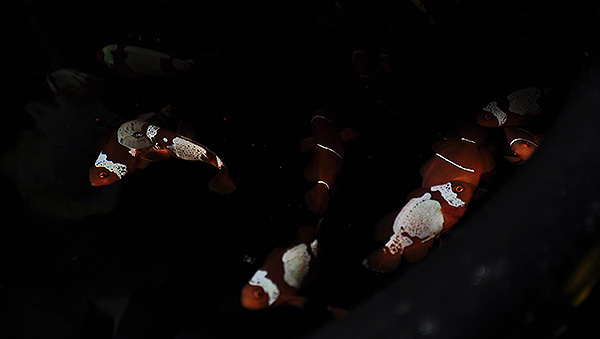
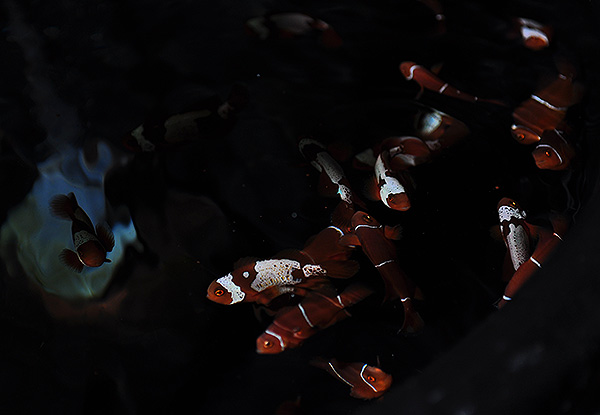


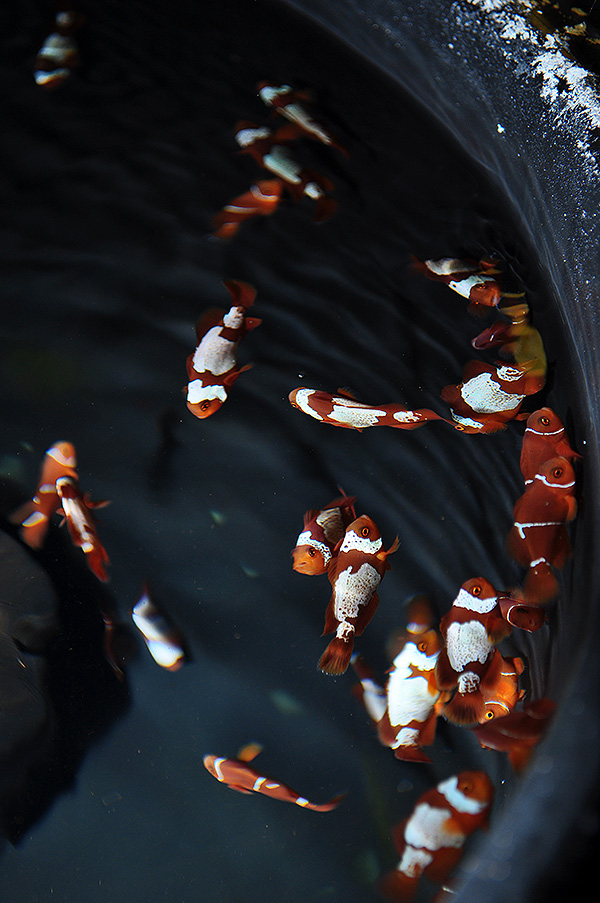

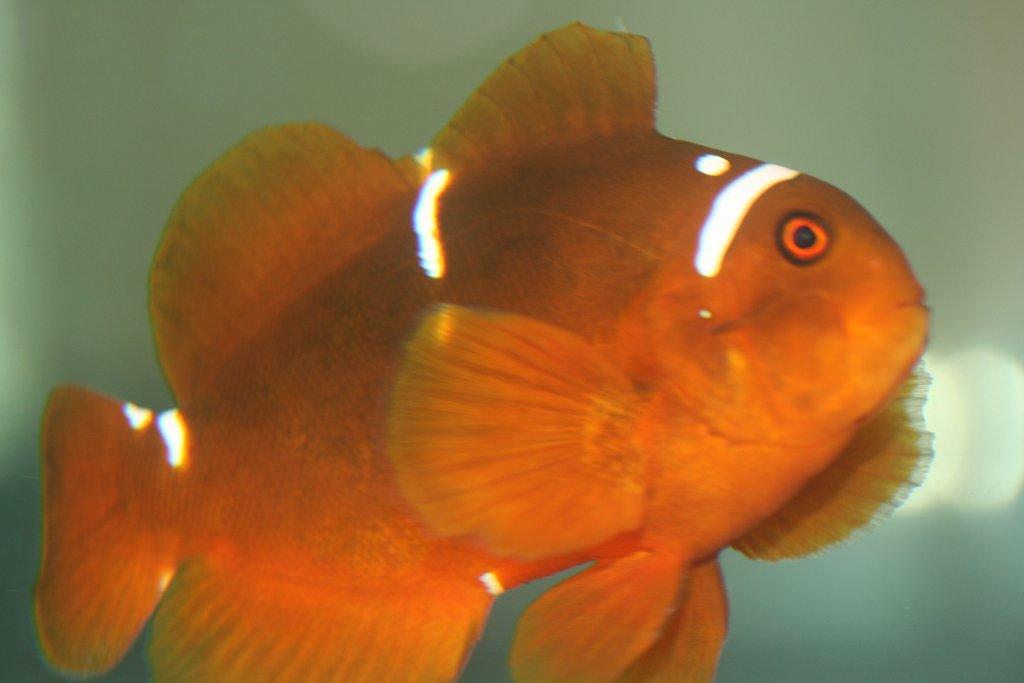
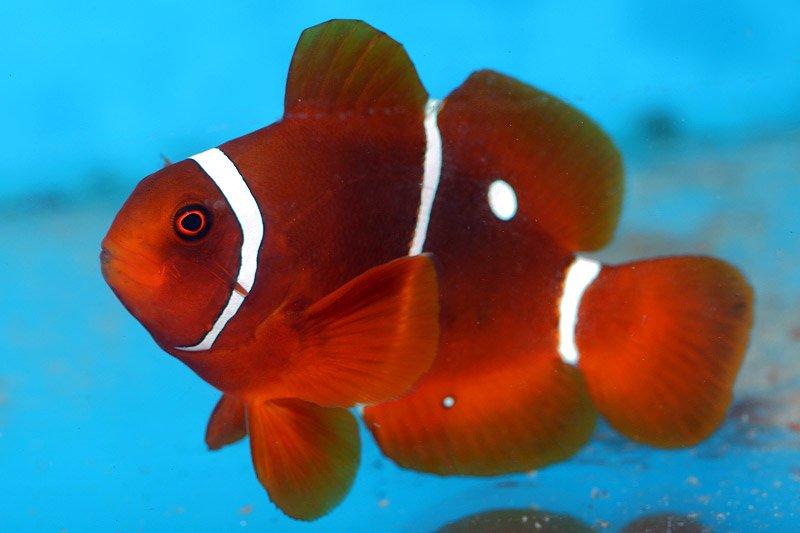
Recent Comments